
The leader in
news and information on
low energy nuclear reactions
November 8, 2007 -- Issue #25
Copyright 2007 New Energy Times (tm)
Published by the New Energy Institute Inc. six times per year
Staff
Editor and Publisher: Steven B. Krivit
Copy Editor: Cindy Goldstein
Web Editor: Sally Robertson
Science Advisers:
Edmund Storms
John Armstrong
Support Team
Randy Souther
H.P.
Nick Palmer
V.F.
Contributors
Bill Collis
P.K. Iyengar
New Energy Times (tm)
369-B Third Street, #556
San Rafael, CA 94901
(310) 470-8189
|
New Energy Times (tm) is a project of New Energy Institute, an independent 501(c)(3) nonprofit corporation that provides information and educational services to help bring about the clean-energy revolution.
|
__________________________________________________________________________________
New Energy Institute gratefully acknowledges the generosity and support of our major sponsors:
New York Community Trust
Anonymous
__________________________________________________________________________________
EDITORIALS AND OPINION
1. From the Editor
2. To the Editor
NEWS & ANNOUNCEMENTS
3. LENR Seminar at San Diego State University
4. Journal of Condensed Matter Nuclear Science
5. American Physical Society LENR Session
6. International Conference on Condensed Matter Nuclear Science - 14
ANALYSIS AND PERSPECTIVES
7. 2007 International Conference on Emerging Nuclear Energy Sciences
8. 8th International Workshop on Anomalies in Hydrogen- and Deuterium-Loaded Metals
9. Introducing the Fulvio Frisone Foundation
10. 2007 Galileo Project Report
11. A Visit With Vittorio Violante of ENEA Frascati
12. International Collaboration Advances LENR Frontier
13. Tritium Discoveries
14. Edmund Storms' Letter to Science, June 25, 1990
15. Bockris' Letter to Science, June 29, 1990
16. Nuclear Power and the Indo-U.S. Nuclear Deal
17. PUBLICATIONS
18. SCIENCE AND ENERGY NEWS
__________________________________________________________________________________
“The energy produced by the atom is a very poor kind of thing.
Anyone who expects a source of power from the transformation
of these atoms is talking moonshine.”
— Ernest Rutherford, 1933 |
__________________________________________________________________________________
EDITORIALS AND OPINION
1. Editorial:
By Steven Krivit

Photo: Daniel Bosler |
The LENR phenomenon very likely will be disruptive science and technology. Highly disruptive. It also may end up in destructive as well as constructive applications.
The potential applications of LENR are a matter of public policy and leadership. Who is listening?
And whose department does LENR now fall into? Traditionally, in the U.S. at least, anything nuclear, be it an application for defense, energy or health, has been the bailiwick of the Department of Energy.
|
With a tabletop nuclear effect, attainable without a particle accelerator or a tokamak, can the Department of Energy conceive of controlling LENR and claiming that its domain is the department’s exclusive authority? If so, it's not going to be easy. And what has the Department of Energy done to proactively investigate LENR? Nothing, as far as I know.
At least the folks in the Department of Defense are concerned and are being proactive. They sent out a request for proposals this spring to quietly initiate LENR investigations. They also had a meeting at SPAWAR San Diego two months ago and decided to put in $250,000 to investigate the LENR Pd/D co-deposition phenomenon for themselves. Bravo to the SPAWAR team! I wish them all luck and success with their project.
Attached to this issue of New Energy Times is my report on the Galileo Project, announced exactly one year ago. The Galileo Project was the first widespread, coordinated replication effort in the history of LENR. I think the results speak for themselves.
I am grateful for the interest and contributions of the Galileo Project team members, the participation of the New Energy Institute sponsors, the CMNS community and even the skeptics who contributed to this project.
For CMNS researchers, as well as researchers in other highly disputed areas of science, I offer the following insights obtained from my involvement with this project:
1. Consider known ordinary explanations seriously.
2. Avoid getting distracted by speculative, theoretical alternative explanations.
3. Apply your limited available resources to work that may lead to confirmation, not disconfirmation.
New data and great discoveries await you!
__________________________________________________________________________________
2. To the Editor
To the editor:
There has been considerable discussion in recent editions of New Energy Times about LENR heat measurements performed at EarthTech International. I am not involved in the research but I follow the field with great interest.
EarthTech’s position seems to be that it must duplicate an originator's experiment and measure the heat in its own calorimeter to be convinced of the LENR excess heat effect claimed by an originator. As far as I know, all of EarthTech’s results have been null.
It would appear, then, that the experiments are either not being duplicated properly at EarthTech or that the measurements in the originator's experiments are faulty.
Many LENR experiments produce nuclear transmutations with unnatural isotopic ratios. These transmutations are proof that nuclear reactions are occurring. As far as I know, EarthTech has never tested for transmutations, and this makes it more difficult to determine whether the LENR experiments there are being duplicated properly.
So far, reproducing LENR experiments on demand has been difficult. It would be helpful if researchers had an additional method that could demonstrate that a calorimeter is able to detect the heat changes in a LENR experiment without having to reproduce the LENR experiment. Also, an additional method would make comparing calorimeters easier. I am not saying that current methods of calibration are inadequate. Furthermore, I think electrochemists are the people most expert in calorimetry. However, a lot of people require additional convincing, and an additional method might help.
If a computer-controlled heat source existed that was able to duplicate the heat versus time curves of LENR experiments with barely measurable heat, researchers could demonstrate what the calorimeter’s accuracy might be in a LENR experiment. A simulator also might make the results more intuitively obvious.
Ideal characteristics for a LENR simulator would be heat resolution to a milliwatt, waterproof, low heat capacity and the ability to add heat capacity to match an experiment.
A simulator also gives researchers a better opportunity to measure the dynamic behavior of a calorimeter.
If an experimenter completes a LENR experiment using a certain calorimeter,
the experimenter might want to simulate the same experiment on the same calorimeter as a means of verification. In this particular case, there would be addition requirements for the simulator. In electrolysis experiments, the optimal geometry would be to put the heat source at the position of the original cathode and to simulate the geometry of the original cathode. Depending on the type of calorimeter, researchers would want to keep thermal gradients as close to a real experiment as possible. Researchers also would want to maintain stirring if the original experiment had it.
A simulator could help demonstrate the state of the art to people outside the LENR community who find it hard to believe that heat measurements that are being made are within the state of the art. A simulator would work for isoperibolic, flow, Seebeck, and other types of calorimeters.
Ron Marshall
Dallas, Texas
The editor replies:
Dear Ron,
Your ideas are very much on target and show great thoughtfulness. For the most part, you may be pleased to learn, these steps have been taken.
However, you may not know about them unless you either understand calorimetry fluently enough to read the papers independently or have the opportunity to discuss the calorimetric procedures directly with the researchers.
In my case, it has been the latter, and your letter comes in a most timely fashion, because I recently discussed such concepts with some of the best in the field. You will find in the article "International Collaboration Advances LENR Frontier," in this issue of New Energy Times, a sampling of some of the validation tests that are performed with calorimetry.
In the hours I spent listening to the principal investigators, I learned of many additional tests they have performed to insure the integrity of their calorimetry. If you have the chance, I would encourage you to review their work in detail or, better yet, give them a telephone call or attend one of their talks.
You will learn about their use of internal heating resistors, test pulses, swapping palladium cathodes with platinum cathodes and other aspects of calorimetry verification.
Perhaps you may have heard of some off-the-cuff remarks from people not skilled in the art of electrochemical calorimetry. Just knowing how to build and operate a mass flow calorimeter is not sufficient; an experimenter must have an intimate knowledge and understanding of electrochemistry and scientific principles to run and evaluate a LENR excess heat experiment properly.
Precise electrochemistry and calorimetry have been performed in this field for 18 years. Some observers, not skilled in the art, are willing to accept the claims of the experts; others are not. Skeptics who are unwilling to recognize the authority of experts in the field are perfectly within their rights.
If skeptics publicly claim, however, that they are sufficiently qualified to perform such experiments and they include as part of their modus operandus the public dissemination of their related null results, then something is amiss.
If skeptics further position themselves as gatekeepers to research funding, they will do little to advance the field, and they certainly will be among the last to avail themselves of the opportunity for scientific achievement and commercial advantage.
On the other hand, researchers who struggle with unlocking the mysteries of LENR excess heat in their own experiments, at great personal cost and sacrifice, eventually will come to understand the secrets of how to create LENR excess heat and will be among the first to reap the benefits.
I have included related text for you, excerpted from a forthcoming article about the early calorimetry in this field. You will see that the Fleischmann-Pons calorimeter was able to discern less than 1 milliwatt of heat. Also, in this issue of New Energy Times, you will see that such precision is no longer needed, because qualified researchers are now reporting results greater than 1,000 milliwatts.
Excerpt from forthcoming article:
Low Magnitude of Heat Effect Critique
Numerous examples of large effects, relative to the calorimetric uncertainty, have been reported in the literature. Calorimeters must be able to measure temperature changes precisely and to maintain such precision over long periods.
Fleischmann and Pons designed a calorimeter that was accurate to +/-0.1 mW for an 800 mW input. Many of their experiments reported excess heat in the hundreds of milliwatts.
One of the most interesting calorimetry critiques was that by Richard Garwin, at one time the director of applied research at the IBM Thomas J. Watson Research Center and a prominent U.S. physicist and adviser to the U.S. government. In October 1993, he, along with Nathan Lewis of Caltech, visited the SRI International laboratory of Michael McKubre, director of energy research. Garwin and Lewis performed an extensive, two-day evaluation of the "cold fusion" research performed at SRI International.
In Garwin and Lewis' report to Lee M. Hammarstrom at the Pentagon, they said, "Uncertainty in excess power measurement is about 50 milliwatts, but the excess power appears to be on the order of 500 milliwatts or even 1 watt peak. However, excess power is still a deduced quantity and depends upon the calibration of the calorimeter."
Conservatively, this provides a signal 10 times that of the uncertainty. However, calibration was a minor issue, according to McKubre, who designed and built this first-principles mass flow calorimeter. It had a 99.3 percent efficiency, and only the 0.7 percent of the remaining conductive and radiative heat depended on calibration.
Further, in Garwin's report, he wrote, "On cells L3 and L4, we note that a chemical reaction involving the Pd at perhaps 1.5 eV per atom would correspond to about 3.5 kJ of heat; this is to be compared with the 3 Mj of 'excess heat' observed, so such an excess could not possibly be of chemical origin."
(Letters may be sent to "letters" at the New Energy Times domain name. Please include your name, city, and state or province.)
__________________________________________________________________________________
NEWS & ANNOUNCEMENTS
3. LENR Seminar at San Diego State University
On Sept. 14, Pamela Mosier-Boss of SPAWAR San Diego presented a seminar on LENR at San Diego State University. She had been invited by chemistry professor Gregory Kalyuzhny, who had performed post-doctoral studies under the direction of Alan Bard at the University of Texas and under Royce Murray at the University of North Carolina.
Mosier-Boss also presented the same seminar to her division at SPAWAR a few weeks ago.
"There were some smirks from my co-workers as they came into the conference room," Mosier-Boss said. "They weren't smirking at the end of the seminar."
__________________________________________________________________________________
4. Journal of Condensed Matter Nuclear Science
The Journal of Condensed Matter Nuclear Science has moved to a new Web location. The journal has been under development for several years, and it finally has released its first issue, located here.
The first issue includes papers by Xing Zhong Li, Fulvio Frisone, Jacques Dufour, Akito Takahashi, Fu-Sui Liu and Hervé Bottollier-Curtet.
__________________________________________________________________________________
5. American Physical Society LENR Session
Next year's APS meeting will take place March 10-14, 2008 in
New Orleans, Louisiana. Scott Chubb has volunteered to organize the session. Submit abstracts to him no later than Nov. 17. Registration and housing information is available at the meeting Web site.
__________________________________________________________________________________
6. International Conference on Condensed Matter Nuclear Science - 14
The 14th International Conference on Condensed Matter Nuclear Science will take place Aug. 10-15, 2008, at the Hyatt Regency Hotel on Capitol Hill in Washington, D.C.
Conference details and registration, when available, will be listed at the ISCMNS Web site.
__________________________________________________________________________________
ANALYSIS AND PERSPECTIVES
7. 2007 International Conference on Emerging Nuclear Energy Sciences
The 2007 International Conference on Emerging Nuclear Energy Sciences took place on June 3-8, 2007 in Istanbul, Turkey.
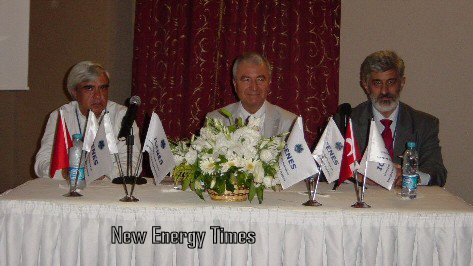
ICENES Conference leaders, from left, Carlos Varandas, Jose Maria Martinez Val, Sumer Sahin
The organizers said they hoped the conference would "provide an international scientific and technical forum for scientists, engineers, industry leaders, policy makers, decision makers and young professionals who will shape future energy supply and technology."
The conference had two main thrusts: fusion research and advanced fission ideas.
Most of the ideas proposed seemed very progressive, projects that would take many decades and reach fruition only in the latter half of this century. This is not a criticism; rather, this group should be commended for taking a long view of energy solutions.
The group had many excellent ideas. The challenge is that the projects and research that many participants propose are antithetical to the political mechanisms that would fund them. This gets to the root of one of the major challenges they face. With political leaders and parties changing every few years, long-term energy strategies and commitments to research programs are almost impossible.
The International Thermonuclear Experimental Reactor project is one notable exception; it attained multibillion-dollar commitments from many nations. With every other magnetic confinement fusion reactor in the world now downgraded to research-only status rather than potential energy-producing machines, all hope for magnetic confinement fusion is on this one humongous reactor to become the be-all and end-all solution for finally generating practical energy from controlled thermonuclear fusion. Or so they say.
Edward Moses, associate director of Lawrence Livermore National Laboratory, spoke about the other big fusion research program: inertial confinement, or laser fusion program.
Moses said that the lab expected its National Ignition Facility to get its first ignition in 2010.
A member of the audience asked him how much energy it would create, and he gave an impressive-sounding number. But then the questioner asked him to clarify whether that meant the facility would generate net energy, and Moses said no, that was not the point.
"NIF should be looked at as an exploration to learn more about fusion, not as an energy-producing experiment," he said.
Moses said that overall efficiency "from the wall plug" to that released from the laser reaction was expected to be only 20 percent of the input power in the foreseeable future.
He mentioned that John H. Nuckolls, director of the lab suggested that, "by 2100, their goal is to capture 10 percent of the energy market."
On the fission side, participants proposed and discussed many ideas for what is called Generation IV Nuclear Energy Systems.
Nearly all the fission power plants in use today are from the family of what's called Generation II reactors, based on technology that is 30 years old.
Generation III reactors have some benefit over Generation II reactors; however, most fission research and development is now in the family called Generation IV reactors.
Generation IV reactor technology has four objectives:
1. Better proliferation resistance
2. Decreased waste
3. Improved safety
4. Improved economics
The bottom line is that the nuclear power industry has been working diligently for decades to redesign and re-engineer nuclear power plants.
An example of the improved safety concepts is that, in the event of a loss of control of a system, passive fail-safes - for example a mechanism that relies on gravity - would take effect and shut down a system.
Fuel would be used more efficiently, on the order of 50 to 100 times better.
Public fear of nuclear power, as well as high costs - at least with the older power systems - have been major impediments to greater application of nuclear fission power. But the proponents in this conference claim to have responded to these concerns and shortcomings with the advances in Generation IV technology, if only they had the support to build them.
__________________________________________________________________________________
8. 8th International Workshop on Anomalies in Hydrogen- and Deuterium-Loaded Metals
By Steven B. Krivit
Photos by Steven B. Krivit (unless otherwise noted)
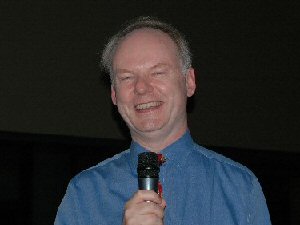 The 8th International Workshop on Anomalies in Hydrogen- and Deuterium-Loaded Metals (aka "Anomalies conference") took place Oct. 13-18, 2007, at the Sheraton Catania hotel in Catania, Sicily, Italy. The 8th International Workshop on Anomalies in Hydrogen- and Deuterium-Loaded Metals (aka "Anomalies conference") took place Oct. 13-18, 2007, at the Sheraton Catania hotel in Catania, Sicily, Italy.
The workshop was organized by William Collis, who has been organizing this
series of conferences since 1997. From 1993 to 1997, the conference series was organized by Fausto Lanfranco of Fiat.
New Energy Times will present two feature articles from the conference in this issue; however, this is only a fraction of the excellent work that was presented there. Some of the presentations will become available soon on the ISCMNS Web site.
Collis reported that he received 58 abstracts for the conference and that 87 people had registered.
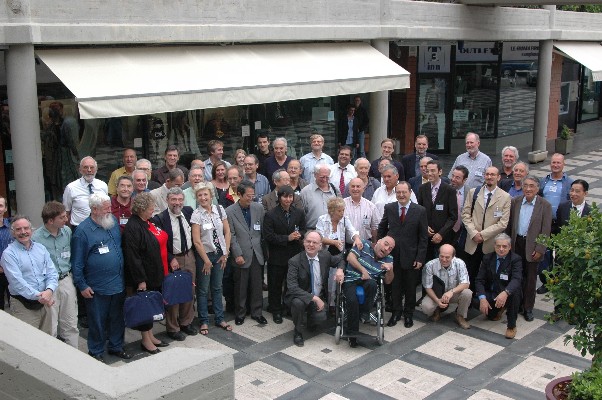
The attendance breakdown by country was Italy (28), France (5), United Kingdom (2), Romania (1), Belarus (1), Russia (9), Kazakstan (1), Israel (4), Norway (1), U.S. (28), Canada (1), Japan (3), and China (4).
Several local representatives, some from the Fulvio Frisone Foundation (see related article in this issue), some from the local government and some from Catania University, helped to officiate the beginning of the conference.
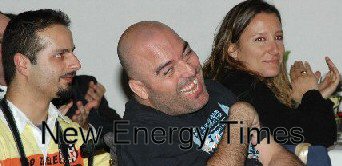
| 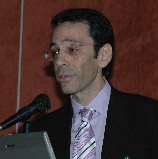
|
Fulvio Frisone, center, receives accolades | Truglio Sebastiano, executive director
of the Fulvio Frisone Foundation |
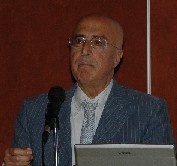
|
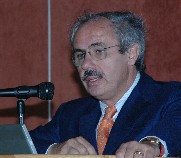
|
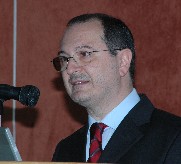
|
Rosario D'Agata, member of the
Fulvio Frisone Foundation
Science Committee |
Lombardo Raffaele, president of the Province of Catania |
Salvo Fleres, president of the Fulvio Frisone Foundation and vice president of the Sicilian Regional Assembly |
Frisone's mother, Lucia Colletta, is the perpetual source of energy that has helped Frisone succeed in the world. She has earned the care and appreciation of people throughout Italy. They affectionately call her the "cyclone."

|
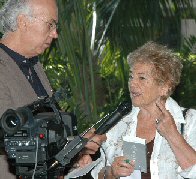
|

|
When Colletta talks, people listen. Or else! |
Attendees were treated to an excursion to nearby Mt. Etna, which fortunately was not very active at the moment, short of a strong draft of sulfur fumes.
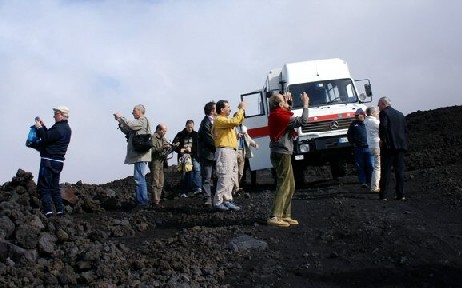
Photo: M. McKubre
CMNS scientists collecting photographic data at Mt. Etna
Giuliano Preparata Award
George Miley, a professor with the department of nuclear, plasma and radiological engineering at the University of Illinois, received a Preparata Award from Francesco Celani.
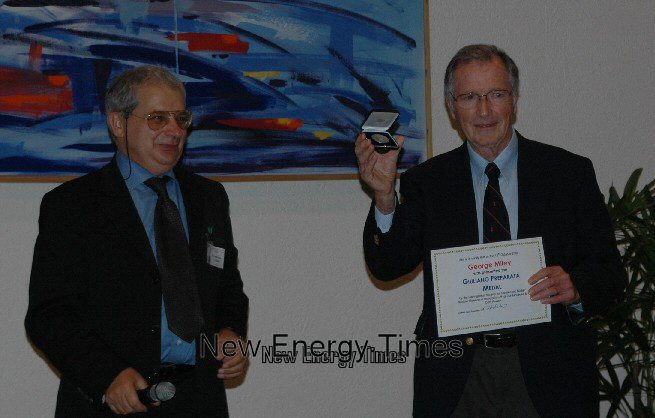
Miley receiving Preparata Award
In return, he presented an inspiring talk in tribute to Preparata, who Miley called "a true pioneer in cold fusion theory."
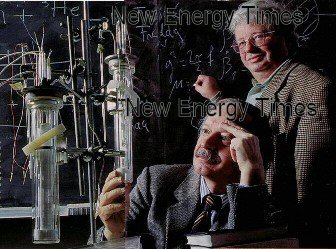
Giuliano Preparata, foreground, Emilio Del Giudice, background
"Anyone who attended an ICCF meeting before 2000," Miley said, "remembers the brilliant and fiery theoretical physicist, Giuliano Preparata. He provided new insight into the deep mysteries of cold fusion and greatly enlivened the meetings with his lively debates."
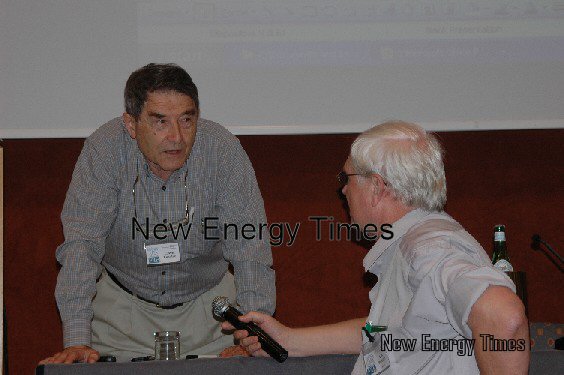
Yuri Bazhutov, right, questions Ludwik Kowalski, left, after his presentation
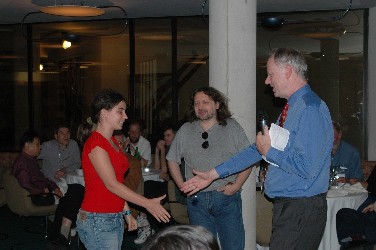
Martina Salvatori receives a prize for best poster from Bill Collis on behalf of Alessandro Marmigi. Professor Antonio Spallone, center, performs crowd control. Alexei Roussetski was the first runner-up for the prize.
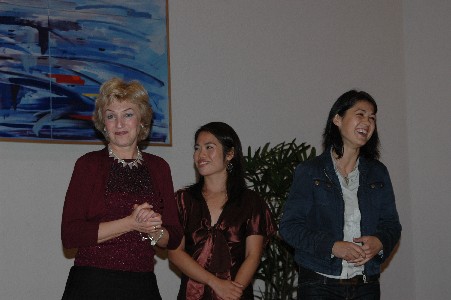
Conference and interpreting staff are honored for their work. From left, Natalya Famina, Salynn Phudtapitug and Raluca Tigau. Not pictured: Alessandro Marmigi and Antonio Spallone.
The response to the conference was overwhelmingly positive, though some attendees wished for more of a "workshop" feel: more time for discussions and brainstorming. The Sheraton Catania facilities, food and hospitality were superb. Logistics, access, a temperate climate and the financial assistance of the local Italian government made this site an attractive venue for future conferences, as well.
|
International Society for CMNS Report
The fourth annual general meeting for the ISCMNS took place Sunday Oct. 14. The results from the elections of new officers were announced. Xing Zhong Li won the position of president; Francesco Celani won the position of chairman.
Bill Collis announced that he had retired from the executive committee as of Dec. 31, 2006, and he became chief executive of the society.
Collis reported that the organization is running in the black, but that the organization maintains a non-interest-bearing account with Paypal, containing €11,000, that has been frozen pending “verification” of the society. Collis reported that Paypal has failed to attempt verification procedures.
The ISCMNS executive committee unanimously decided to subsidize publication of the ICCF-13 proceedings by $3,000, which would allow printing of 300 copies of the proceedings.
Collis is involved in a significant amount of paperwork to steward the organization's growth as a registered U.K. charity organization. He is to be commended for his efforts.
In related activity with the society, he noted that it has talked with groups interested in forming international research projects, though he remarked that such programs may be considered risky, because they fall on the periphery of the organization's legal charter.
|
|
Instructions to Anomalies 8 Authors:
Submission deadline for conference proceedings is Jan. 1, 2008. Authors should send manuscripts to JedRothwell@mindspring.com and receive a reply. Rothwell recommends that authors should follow up with him if they do not get a confirmation reply, because some e-mail systems have not been reliable.
Additional details:
- Authors should include an abstract of one or two short paragraphs.
- There will be a printed edition and an optional online edition at ISCMNS. The printed-edition page limit is eight. Figures will be black and white.
- The online edition has no page limit, so authors can write a longer version with more text, images, color photographs and spreadsheets or another copy in Russian, Italian, Japanese or any language.
- Any word processor format is acceptable. Do not send in Acrobat format.
- Authors do not need to follow any formatting guidelines. Editors Rothwell and Peter Mobberley perform all editing.
|
__________________________________________________________________________________
9. Introducting the Fulvio Frisone Foundation
By Bill Collis
(Photos by Bill Collis)
(Reprinted courtesy of Infinite Energy)
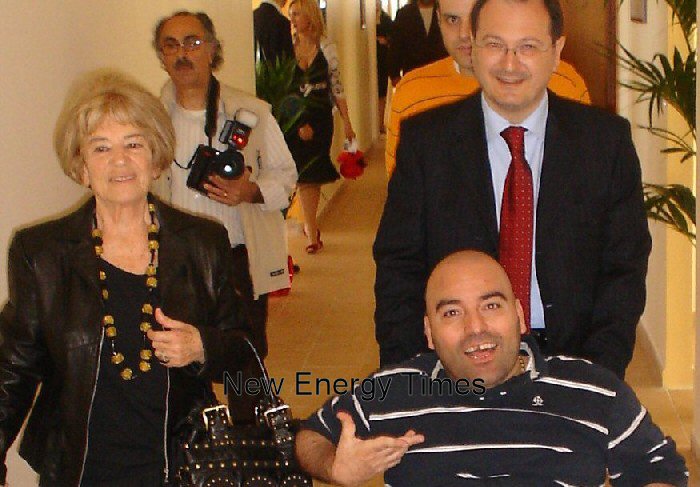
Fulvio Frisone arriving at the opening ceremony with his mother, Lucia Colletta, and Salvo Fleres, President of the Fulvio Frisone Foundation and Vice-President of the Sicilian Regional Assembly
On May 7, I was standing outside the new Melilli Research Center in Sicily. It was the formal opening ceremony. Cars and coaches were arriving and there was a party atmosphere. The hostesses distributed information packs, the Italian police, or Carabinieri, were present in force, protecting perhaps some of the senior politicians and other dignitaries. Journalists were taking pictures and conducting interviews. The majority of the participants were ordinary people of all ages.
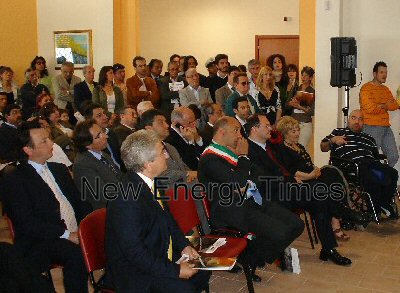
| 
|
Opening ceremonies drew many dignitaries and a full crowd | The Fulvio Frisone Foundation building in Sicily |
As I came out to enjoy the morning sunshine on that warm Sicilian day, it was warm, of course, but up on the hill here, a pleasant breeze brought the exquisite fragrance of oleanders and figs. We were 10 km from the Ionian Sea, but from this height, there was a magnificent panorama of both the Mediterranean and the coastal plain.
However, something spoiled the view. Below, near the coast, through the haze, I could see the tall chimneys of the petro-chemical industry. Built in the aftermath of World War II, this industry has provided jobs and wealth for Sicily. Down below, the odor was quite different: acrid unsaturated hydrocarbons and aromatics. You might guess that this is not only an unpleasant environment in which to work; it is also unhealthy. In fact, there is a significant increase in industrial diseases and tumors in the area.
The Comune di Melilli (municipal administration) has teamed with the Fulvio Frisone Foundation to study some of the problems scientifically. Not only will the Comune lease the lab buildings to the foundation rent-free for 20 years (renewable for a further 10 years), it also will finance three years of research to the tune of half a million Euros. In addition, the foundation will contribute 140,000 Euros for the capital cost of office and lab equipment. It also will pay the day-to-day operating expenses.
Clearly, the foundation is taking a long-term view. The environmental studies are expected to last three years, but the foundation’s lease will last 20 or 30 years. There are five experimental laboratories and another five rooms for offices and meetings. Clearly, space for expansion is ample. No doubt the foundation will seek other sources of funds to make good use of these facilities. (See interview with Fulvio Frisone.) I think we’ll see LENR research, both experimental and theoretical, being carried out.
So what is the Fulvio Frisone Foundation? It’s a nonprofit organization established by an act of the Sicilian regional assembly (legislature) to carry out scientific nuclear physics research, organize seminars and collaborate with universities and other research institutions, and assist disabled researchers
Fulvio Frisone himself has been disabled from birth. Confined to a wheelchair, he has difficulty speaking and writing. Demonstrating the most extraordinary courage and perseverance, he survived the Italian school system and earned a degree in nuclear physics at Catania University. He has attended many international condensed matter nuclear science meetings, beginning with the Asti workshop in 1997.
His case has been brought to the attention of the media and Sicilian politics, thanks to the efforts of his mother, Lucia Colletta, affectionately know as the “cyclone” in some circles because of her energy! Attention also has come from the open letters of support signed by Frisone’s colleagues at international meetings.
As a result, the Sicilian region has passed a number of laws specifically in his favor, culminating in the establishment of the foundation itself. He has important friends in high places!
Books have been written about him, and a film, “Il Figlio della Luna,” was made for national television. Frisone is quite famous in Sicily. When he accompanied me to the airport, many well-wishers came up to shake his hand and congratulate him!
Although the foundation was legally established in 2004, it became operative only in 2007. Apart from the management of the laboratories at Melilli, two other major initiatives are under way this year. First, modest financial awards have been and will be given by the foundation to recognize CMNS researchers. Five such researchers have received awards, and further candidates are being considered.
According to Dr. Sebastiano Truglio, director of the foundation, the following individuals received grants in 2005 and 2006: Emanuele Castagna, Vittorio Di Stefano, John Fisher, Alexander Karabut, Xing-Zhong Li, Paolo Marini, Alessandro Marmigi, Irina Savvatimova, Antonio Spallone, and Edmund Storms.
Second, the foundation is a major sponsor of the 8th International Workshop on Anomalies in Hydrogen/Deuterium Loaded Metals, which took place Oct. 13-18 at the Sheraton Hotel and conference center near Catania.
Thanks to this generous sponsorship, the cost of participation was half what the hotel bill alone might have been. In addition, many deserving researchers successfully applied for reduction or waiver of their fees. The conference was one of the most popular workshops ever, and Sicily is well-poised to be the venue for a future ICCMNS conference.
Brief Interview With Dr. Fulvio Frisone
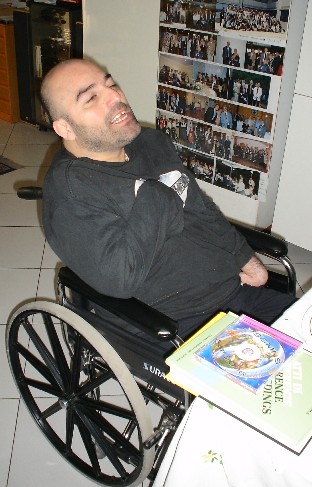 Bill Collis: First of all, Fulvio, may I congratulate you and the Fulvio Frisone Foundation on this scientific initiative. Bill Collis: First of all, Fulvio, may I congratulate you and the Fulvio Frisone Foundation on this scientific initiative.
Fulvio Frisone: Thank you.
BC: Can you say, in a few words, what the objectives of the laboratory are?
FF: Well, of course, everybody has their own expectations for the laboratory, and these are not always realistic. Proposals include studies on tumors, stem cells, eco-compatibility. . . . The formal protocol also foresees studies on environmental toxins.
BC: What kind of budget and time scale are we talking about here?
FF: As a minimum, the FFF will contribute 140,000 Euros and the Comune of Melilli another 500,000 Euros over a period of three years.
BC: How many people do you foresee will be working in the lab in a year’s time?
FF: We have already recruited three molecular biologists and a microbiologist. Within six months, the scientific staff will double to eight.
BC: Who will be in charge of the lab?
FF: I’m the director.
BC: I see that the FFF will constitute a scientific committee. Will this committee oversee the lab?
FF: Yes. It will approve the research plan and results and evaluate individuals. The precise roles will be approved this summer.
BC: What other activities is the FFF involved in?
FF: At Palermo, we’re studying Williams Syndrome, which is a genetic problem.
BC: How can we find out more about the FFF?
FF: We have just opened our Web site.
BC: Are you looking for international research partners?
FF: Definitely! However, our policy is not to sponsor any research carried on outside Italy. We can and do make modest awards to researchers, whether overseas or not, in recognition of work already carried out and published.
BC: Do you intend to invite foreign scientists to work in your labs in Sicily?
FF: Yes, and of course we are willing to collaborate with labs overseas.
BC: How do you see the FFF evolving in the future?
FF: The FFF is like a young child. It’s premature to say exactly what the future will bring. But you can be sure we will be alert to opportunities as they arise. For example, we are evaluating international collaboration under the European Union’s FP-7 program.
BC: Your ambitious plans are going to require substantial funding. How do you propose to raise the necessary finances?
FF: At present, we are dependent on the generous funding of the Sicilian regional government, but we will certainly need to diversify our sources. We will approach the petro-chemical industry, the Italian bank foundations and individual well-wishers.
BC: Do you foresee any legal problems in opening a lab? Are there any special permits required?
FF: No, these problems are already solved.
BC: What about the FFF constitution? Does it allow research into areas outside nuclear physics?
FF: Well, you know, physics, even nuclear physics, touches on almost every area of science. Neutron activation analysis or X-ray fluorescence spectroscopy are useful atomic techniques to identify polluting elements in the environment.
BC: What kind of CMNS research would you like to see, personally?
FF: Theoretical models, because I’m a theoretician!
BC: Thank you, Fulvio, for a very interesting discussion.
__________________________________________________________________________________
10. 2007 Galileo Project Report
The Galileo Project was a New Energy Institute program initiated in July 2006 in response to the claims of a remarkable experiment developed, performed and published by the San Diego SPAWAR Systems Center group. We first reported the details of this experiment in the Nov. 10, 2006, issue of New Energy Times.
New Energy Institute subsequently organized a coordinated replication effort, initially with 34 people from three countries.
__________________________________________________________________________________
11. A Visit With Vittorio Violante of ENEA Frascati
By Steven B. Krivit
Photos by Steven B. Krivit
One and a half euros and a train ride from Rome's Termini will get you to the small quiet town of Frascati in 20 minutes. As you walk out of the train station you quickly find yourself on Via Enrico Fermi, named in honor of one of the greatest Italian physicists. From there, it's just a few hundred meters to ENEA.
ENEA Frascati, the Italian Agency for New Energy, is a government laboratory and one of the largest fusion research centers in Europe, comprising 500 researchers. Although it was built in 1960 for magnetic confinement fusion research with tokamak reactors, its researchers perform studies in other fields of fusion research. They also study the low energy nuclear reactions in the field of condensed matter nuclear science.
Vittorio Violante is responsible for the activities in the LENR lab in the technology division of ENEA Frascati. He earned his doctorate in material engineering from Calabria University and began his career at ENEA in 1980 through a fellowship; he worked on the fuel cycle for tokamak reactors. Several years later, he worked in the U.S. at Argonne National Laboratory for a year through another fellowship, then returned at the end of 1983 to a permanent position at ENEA.
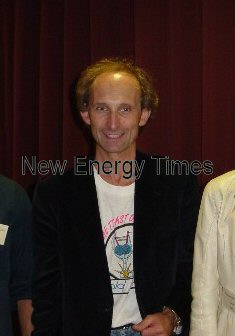
Vittorio Violante
He also has been involved in several other international collaborations: in the U.S. with the National Bureau of Standards while performing advanced chemical reactors and separation process research, and in Germany with the Max Planck Institute in 1987-88 working on the Next European Tokamak project, which merged in 1988 with other countries to become the ITER project.
He has worked with George Miley at the University of Illinois and is a contract professor at the University of Rome-Tor Vergata, teaching physics of energy conversion. He also was a contract professor at the University of Calabria teaching transport phenomena.
He remembers the very first day he heard about "cold fusion."
"I was driving to work on March 23, 1989," Violante said, "and I heard the surprising news on the radio. When I arrived at work, all my colleagues had heard of it, too."
Two groups at ENEA began to work on LENR research right away. One group was headed by Francesco Scaramuzzi in the advanced technologies department; it focused on gas phase experiments.
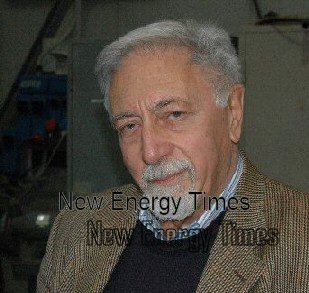
Francesco Scaramuzzi
The other group, in the fusion department, was headed by Francesco De Marco, and this group performed work on electrolysis experiments. Violante worked in this group, and in 1992 the two groups merged. The LENR research is part of the fusion department of ENEA activities.
In 1997, Violante became the head of a section specializing in nuclear special technologies for fusion. This shift moved him from the laboratory into research management. During this time, and through 2001, he continued to work on LENR, focusing on the theoretical aspects of the field.
Violante is one of only a handful of researchers who have worked in both the experimental and the theoretical realms.
In 2001, he left the management position and returned to the lab.
Violante has been reporting excess heat for 17 years.
"The first clear excess heat experiment was back in 1990," Violante said. "We worked on a joint project with Appleby at Texas A&M University because they had the expertise in precise calorimetry."
They observed 10 percent to 20 percent excess heat, producing 50 mW, significantly above the level of uncertainty, Violante said.
"Once the researchers observed excess heat in this experiment, they sent a heating pulse of 115 mW into the cell," Violante said, "to make sure that the instrumentation was working properly. The calorimeter responded with a signal of an extra heat pulse of precisely 115 mW."
Later in 1992, Violante began to look deeply into the materials science issues.
"I became aware of the threshold effects," Violante said, "after observing the work of Mizuno and McKubre. We would see that one lot of Pd would give a lot of excess heat, yet another would not. I asked why."
"We realized that the self-induced stress into the material due to the loading was opposing the deuterium flux," Violante said, "and that, if we could keep the stress down during the loading, it will absorb more Pd."
Violante explained more about the stress field. He explained that, normally, when deuterium loads into Pd, the Pd elongates. The higher the concentration of hydrogen or deuterium, the greater the elongation, and this produces a stress field. As with any material, stress occurs if one side of a material is subjected to a high temperature and the other side is exposed to a low temperature.
Violante has been able to even out the stress field as the deuterium enters the Pd. He's learned how to load the deuterium into the Pd more or less along a reduced gradient, and therefore the elongation occurs more evenly and, as a result, maintains its structural integrity better.
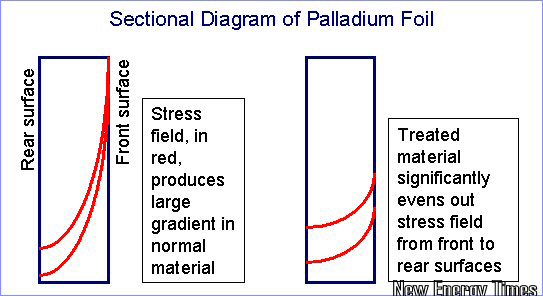
In 2003, at the Tenth International Conference on Cold Fusion, he reported simultaneously with, and independent of the report from Dennis Cravens and Dennis Letts, the use of laser-irradiation onto the cathode surface to help drive the LENR experiments.
"It was not just an intuition," Violante said. "My work in theoretical modeling was very helpful to guide me to the use of lasers."
Violante speculates (and calculates) that surface plasmon polaritons have a significant role in LENR triggering.
Violante has developed a method of preparing Pd foils, through a process of surface treatment and cold rolling that provides remarkably high deuterium loading when the foils are used in LENR experiments. High loading, or hydrogen/deuterium absorbtion, has been found to be a threshold requirement to obtain the sought-after LENR excess heat effect.
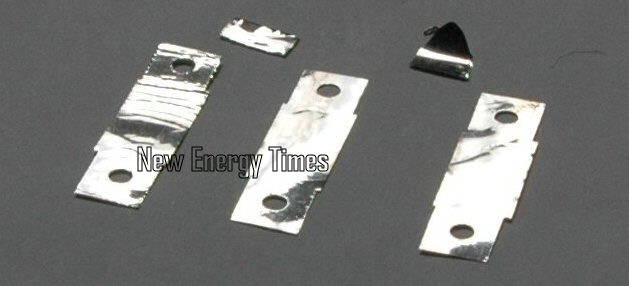
Palladium foils
Normally, the loading ratio is derived by measurements of the electrical resistance of the palladium hydride within the electrochemical cell.
In 2006, Violante, working with researchers at the Naval Research Laboratory on a material science investigation, went to Brookhaven National Laboratory and performed an in-situ X-ray diffraction analysis during an electrochemical loading of palladium with hydrogen.
A government researcher commented on the results of the test at Brookhaven.
"We just returned from Brookhaven," he said. "Three of Violante's cathodes went to over 0.95 D/Pd (up to 1.02) and one cathode with H went up to H/Pd of 1.1. So his batting average is 100 percent as far as I am concerned."
Their observations using the X-ray analysis independently confirmed the very high loading, in agreement with the values calculated from the resistance measurements.
On his office wall, next to photos of Einstein and Fermi, Violante has a framed graph of this achievement; a simple curve showing the loading ratio that approached 1-1.
"Loading deuterium into Pd at these levels is new ground," Violante said. "You cannot find information about these conditions in textbooks."
It's not only the amount of deuterium that they can load into Pd, Violante said, but it's also the flux, that is, the amount of deuterium particles loaded into Pd in a given amount of time.
In addition to his team at ENEA, he also has a working contract for scientific collaboration with Concita Sibilia at the University of Rome-La Sapienza to explore the conditions of the Pd surface in greater detail.
The ENEA LENR laboratory is one of the most well-equipped LENR labs in the world, and the resources and tools available to Violante's team are no doubt an integral part of the ability to develop Pd cathodes that have an exceptionally high success rate.
For cathode manufacture, the team members use an Italian-made roller to take the Pd that they receive from the manufacturer at 1000 microns thick down to 50 microns. It is a multistep process that is guided largely by experience as well as calculations. They must pass the Pd foils through the roller many tens of times. The exact protocol is based on the condition of the raw material as they receive it from the manufacturer. If you go too fast, the metal will break.
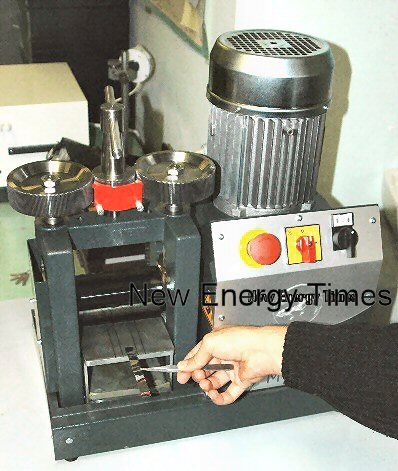
Rolling machine
They prepare their chemicals inside a glove box filled with argon. This helps to maintain, among other things, the purity of the D2O from ambient water vapor.
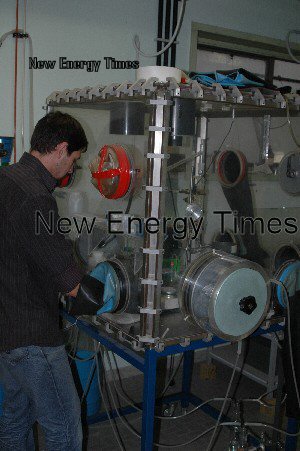
Glove box
Their next step is to bake the Pd foils in an oven for one day at 900 C. After rolling, annealing is required to rebuild the grain. The rolling process produces structural defects, and the annealing reorganizes the grain structure of the metal, making a suitable grain size distribution for good loading. Unless the material is rebuilt properly, high loading is difficult to achieve.
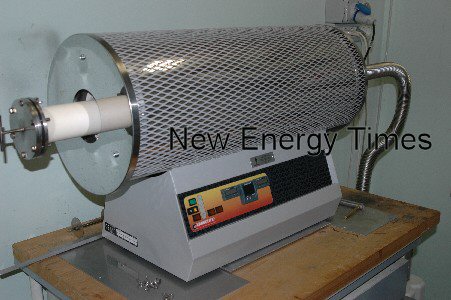
Annealing oven
Another way of looking at it, as explained by Michael McKubre, director of energy research at SRI International, is that the annealing process allows defects to disappear and instead promotes the growth of stronger, more consistent palladium crystals.
"One of the goals of the process is to get all crystals the same size," McKubre said. "This helps to create a material that can accept high loading."
All of their cells, either glow discharge or electrolytic, are placed inside thermostatically controlled chambers to isolate the cells from the ambient environment and insure accurate measurements of the heat production.
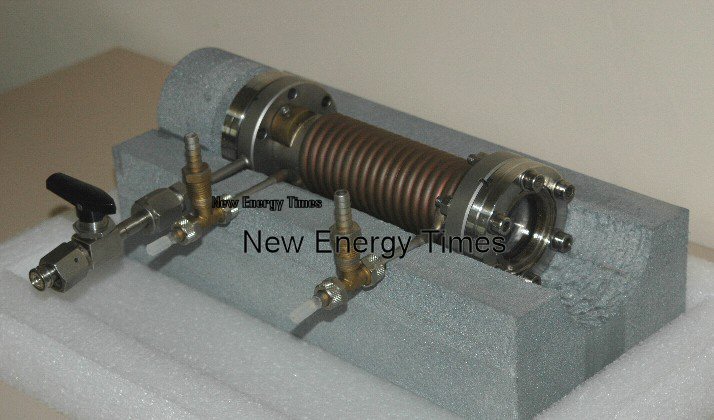
ENEA glow discharge LENR cell surrounded by flow calorimetry coil
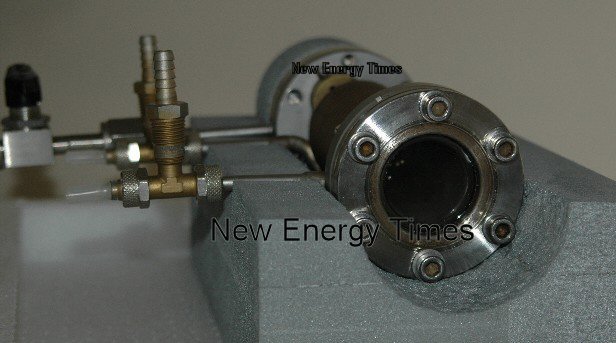
ENEA glow discharge LENR cell, seen from port end
|
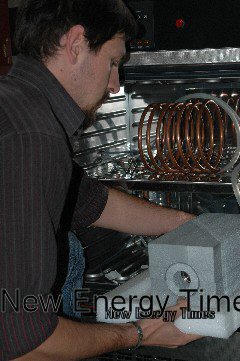
|
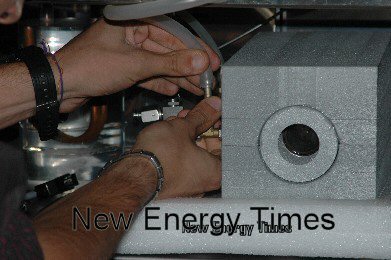
|
Assembling the glow discharge cell, encased in insulation, into
thermostatic chamber
|
Connecting coolant pipe
|
|
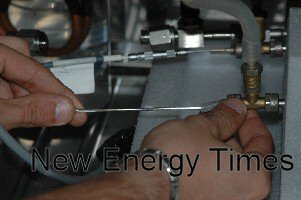
|
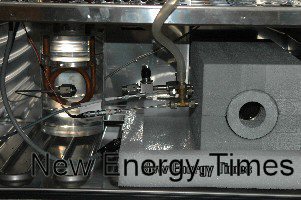
|
Inserting the thermocouple into
dual-purpose t-connector
|
Assembled cell
|
|
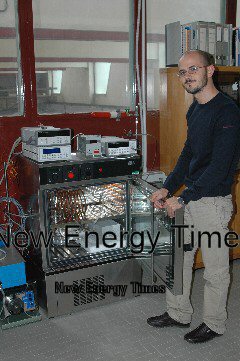
|
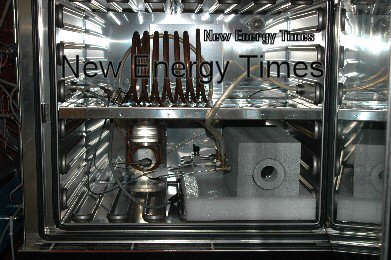
|
Cell in thermostatically controlled chamber
|
Cell on bottom right, coil and bath on top and bottom left for temperature-stabilization of calorimetry fluid |
Violante said that the operation and the parameters of the cells can all be controlled remotely, through software he helped design that enables the possibility for researchers from across the world to operate their own experiments in the Frascati facilities.
Violante is enthusiastic about his recent collaborations with other LENR researchers.
"We've had great results here," Violante said, "60 percent repeatability in our lab and then even higher, 70 percent at SRI by using ENEA cathodes, where they obtained, as we did, more than 100 percent power in excess of the input.
"This is encouraging, but it's only a starting point. From here, we have to develop more fundamental knowledge of this phenomenon, and such collaborations with other institutions provide an essential step along the way."
However, Violante and his colleagues at ENEA can easily see how a much larger team, because of the interdisciplinary nature of the research, would be advantageous to the field.
"We need a new generation studying this," Violante said, "and we need to facilitate the transfer of the reproducibility to other labs."
Violante is off to a good start, with four colleagues working with him in the LENR laboratory, all significantly under the mean age, perhaps 65 or 70, of the longtime LENR researchers.
Violante appears to be holding the secrets to the foil preparation within the proprietary domain of ENEA; however, he did say that others on his team know how to prepare the foils.
The metallurgical secrets behind successful deuterium loading and LENR excess heat are probably not beyond the realm of other metallurgists in the field. John Dash, who teaches LENR to summer interns at Portland State University, has reported great success with his foils. However, his approach has been to teach the fundamentals of the science to students rather than to develop extensive calorimetric data for publication.
A group headed by Bob Huggins, a materials scientist at Stanford University, holds the honor of achieving the first sign of LENR excess heat following the Fleischmann-Pons discovery in 1989.
1. Optical Analysis
After the ENEA team fabricates their foils, they first use an optical microscope equipped with a digital camera to make the initial assessment of the cathodes. They look for grain size, orientation of grains and other metallurgical aspects.
They also inspect the foils after the experiments, looking for significant changes in the metallurgy, the introduction of defects or cracks and possible contamination from the electrolysis.
The major emphasis of their work is to better understand the structural characteristics of the bulk of the palladium cathode foils, as well as the surface characteristics.
They know that obtaining full repeatability and reproducibility of the LENR excess heat effect and, from there, the amplification of the effect depends highly on characteristics of the cathode material and its treatment.
2. SEM Analysis
From there, they can move to the scanning electron microscope (SEM) which uses energy dispersive X-ray analysis (EDX) for a microanalysis of the elemental composition of the cathodes. The machine shoots electrons at a target, and the reflected scatter of electrons provides a two-dimensional image of the surface morphology. The electron beam also causes X-rays to radiate from the surface of the target, and these are used to detect the atomic species of the target material.
The SEM/EDX is a remarkable and efficient instrument; the operator observes the inside of the chamber through a video camera and can articulate the microscope stage precisely through remote control.
Within seconds, the operator sees the target material at many thousands of times magnification on the screen of the personal computer that is controlling the SEM/EDX. The operator typically views the samples at 20,000x. Once the operator finds an area of interest, he or she pushes a few buttons, an energy dispersive X-ray detector records X-rays emitting from the target, and the response is analyzed and displayed on a second screen, providing the elemental spectrum of the target.
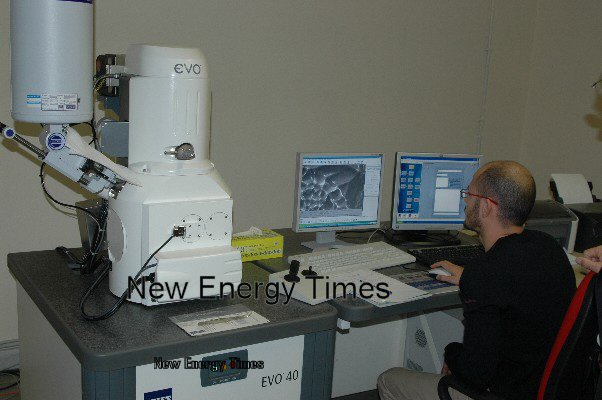
SEM//EDX machine and operation console
This tool helps CMNS researchers better understand the characteristics of impurities in the palladium before experiments as well as after experiments. It also provides information on the various surface treatments and cleaning procedures they may use on the cathodes.
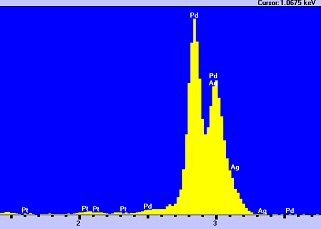
SEM/EDX spectrum from post-LENR experiment
Image: John Dash, Portland State University, Corissa Lee, Gresham High School, Shelsea Pederson, Clackmas High School
3. SIMS Analysis
The next tool they use is the secondary ion mass spectrometer, which provides higher sensitivity of the chemical analysis of the cathodes. The basic concept of the device is that it shoots a beam of argon ions at the sample, particles sputter off, then they are recorded by the quadropole mass spectrometer. It operates under a high vacuum, at 10-9 Torr.
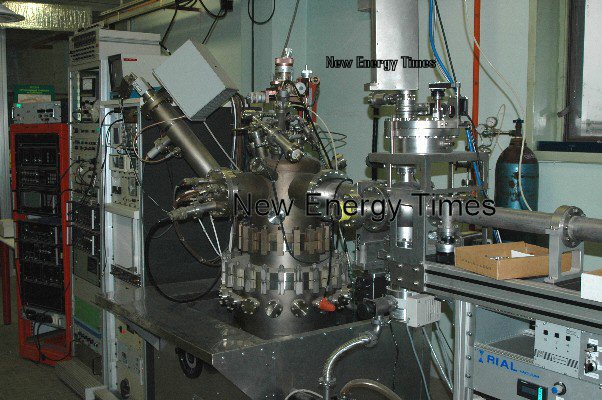
SIMS machine
The SIMS and the SEM/EDX machines have different abilities to analyze surfaces and depths of materials. Both do chemical analysis.
The SIMS machine looks at a wider surface area, about 1 millimeter, whereas the SEM/EDX looks at surface areas about 1 to 2 microns across.
The SIMS machine can take readings from very thin layers of material and, over time, by eroding the surface, obtain data layer by layer from the material's strata.
With the SEM/EDX, operators can test a volume about 1-2 microns deep. They find this to be an important tool to check for contamination, because it provides significant depth resolution.
Additionally, their SIMS machine has better resolution with lighter mass elements, whereas their SEM/EDX machine has better resolution with heavier masses.
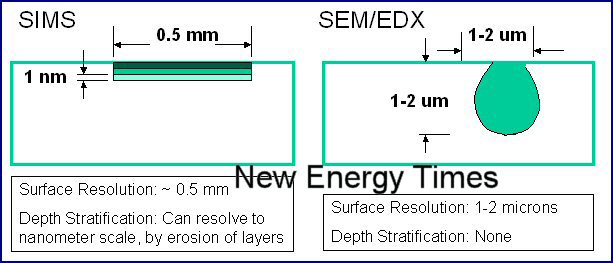
4. AFM Analysis
The next tool in their lab, which is rather amazing, is an atomic force microscope. This tool provides profile surface analysis of the target materials and their morphology. As the name suggests, this tool can be used to see shapes down to the nanometer and even atomic level, to 10 to 100 million times magnification, though they typically view the materials at 200,000x. If operated under a vacuum, theoretically they can see individual atoms.
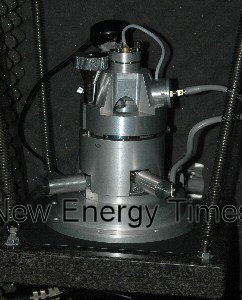
Atomic force microscope, only
16 inches tall
The device works similarly to a phonograph needle and arm. A tip is balanced carefully on a cantilever and rides along the target surface. The travel of the tip is able to provide x, y and z coordinates of the surface, and this shows up on the screen of the controlling personal computer like a topological map.
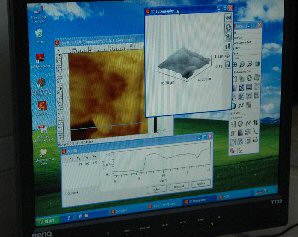
|
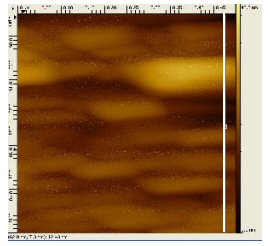
|
|
AFM Console screen |
2-dimensional planar view, white line
indicates selection for z-axis mapping
|
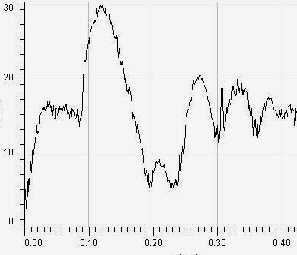
| 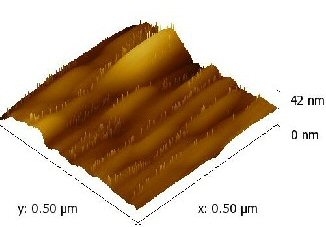
|
Z-axis mapping of selection shown above |
3-dimensional computer image of topology |
Remarkably, as powerful as the atomic force microscope is, its physical size is tiny, nearly half the size of the optical microscope sitting to its right on their lab bench.
The machine does have some limitations. The tip is triangular in shape and consequently cannot travel down into deep narrow valleys, such as those created by charged particles in solid-state nuclear track detectors.
5. Helium Analysis
Before beginning any experiments in which they hope to measure helium, they perform a leak test on the cell. They begin their experiments with a starting value of helium at the same as the ambient level. The researchers try to observe an increase in the helium partial pressure above the ambient value. Therefore, for these experiments, the critical factor is not to avoid the entry of helium into the cell from the environment but rather to avoid helium leakage out of the cell, if any is produced.
Because their test for leakage provides them with a high level of confidence of the structural integrity of the cell, they know that, if any increase in helium exists in the cell after the experiment, the helium was generated by the experiment. Suggesting that helium forced its way into a sealed chamber, resulting in a higher concentration than the ambient value, would be illogical.
Consequently, the generation of helium inside the cell is proof of a nuclear reaction, particularly if this production, as they have previously reported, is correlated with energy gain because of excess power. These measurements are in agreement with others performed in the past by groups using similar experimental conditions, including those at SRI International, a group led by Daniele Gozzi at University of Rome and others.
Violante explained that they are able to perform helium analysis in-situ, online, during and after experiments with the use of a special high-resolution mass spectrometer that is designed to work with low-mass elements and can discern effectively between D2 and H.
Violante pointed to one data set that showed the machine's ability to distinguish deuterium, showing an atomic mass of 4.028204 from helium-4, showing a mass of 4.002600.
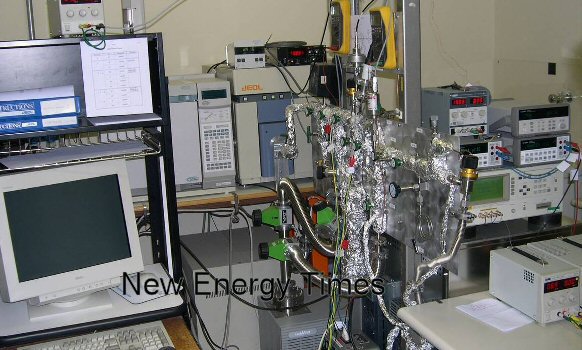
ENEA high-resolution mass spectrometer
"We can see the difference between the two at several orders of magnitude higher than the machine's resolution," Violante said.
"My philosophy," Violante said, "is that it is important to provide the scientific community with convincing experimental data. And to do this, we must obtain signals very high above the noise, data that cannot be questioned."
__________________________________________________________________________________
12. International Collaboration Advances LENR Frontier
By Steven B. Krivit
Introduction
An international collaboration sponsored by the U.S. government's Defense Advanced Research Projects Administration, the U.S. Naval Research Laboratory, the Italian National Agency for New Technologies, Energy and the Environment in Frascati and privately held Energetics Technologies, in Califon, N.J., and their wholly owned subsidiary in Omer, Israel, has made tremendous strides in advancing the state of the art in low energy nuclear reaction research.
Researchers from most of these laboratories reported their results to the scientific community this summer at the 13th International Conference on Condensed Matter Nuclear Science in Sochi, Russia, and in October at the 8th International Workshop on Anomalies in Hydrogen- and Deuterium-Loaded Metals.
The latest set of experiments have shown reproducible LENR excess heat in three laboratories, ranging from 60 percent to 70 percent repeatability among the labs, producing 1,000 to 2,000 milliWatts of heat in several experiments for up to several hours.
DARPA has approved a Phase 2 of funding, according to Michael McKubre, director of energy research at SRI International, the principal investigator on the project.
Collaboration Team
The research effort comprises the following individuals and organizations:
- Michael McKubre, Francis Tanzella, SRI International, Menlo Park, Calif.
- Vittorio Violante, Francesca Sarto, Emanuele Castagna, ENEA Frascati, Italy
- Graham Hubler, Ken Grabowski, David Knies, Naval Research Laboratory, Washington, D.C.
- Irving Dardik, Alison Godfrey, Energetics Technologies, New Jersey
- Tanya Zilov, Arik El Boher, Shaul Lesin, Mark Tsirlin, Energetics Technologies, Omer, Israel
- Ehud Greenspan, Lawrence Berkeley Laboratory, Berkeley, CA.
- Concita Sibilia, Department of Energetics, University of Rome-La Sapienza, Italy
The project had four main components that contributed to its success:
1) Researchers skilled in the art
2) Special preparation of the bulk and surface of the cathodes
3) Special application of a modulated signal into the cells
4) Funding
The primary researchers on the team have been active in LENR research for 18 years. They have all, at one time or another, claimed to have observed excess heat in their experiments and, without a doubt, have risked their reputations in doing so.
This group was once called a "dwindling band of true believers" by Robert Park, representing the American Physical Society.
SuperWaves
A key component of the group's success is a phenomenon called SuperWaves, a trademark of Energetics Technologies.
SuperWaves are the brainchild of Irving Dardik, at one time a practicing physician, who has achieved recognition for his role in training Olympic athletes and infamy for his views on health which made him persona non grata in the eyes of the American Medical Association.
SuperWaves are multiple fractally nested waves of varying amplitudes and frequencies. The modulated waves are introduced to the LENR cells by way of the applied current.
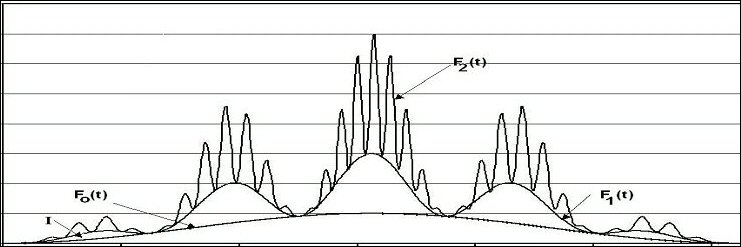
Third-order SuperWave
The teams have found that the application of SuperWaves to the LENR cells contributes to the creation of the nuclear active environment. This environment dictates that a key threshold must be achieved to attain conditions that will support excess heat reactions.
In this case, the key threshold that is enhanced by SuperWaves is the ratio of deuterium loaded into the palladium, the loading ratio. Additionally, the rate at which palladium can absorb the deuterium, the flux, is also greatly enhanced by the SuperWaves, according to McKubre. Without proper loading, LENR cells typically don’t generate any net energy.
"The set of experiments performed with the SuperWaves was the most consistent set of highly loaded experiments in our history of performing this research," McKubre said.
On a technical note, because the power into the cell varies as the SuperWaves modulate the current, data is taken several hundreds of times per second in order to obtain accurate values for the input power.
Materials Science
Materials science, particularly the preparation of the cathodic material in LENR experiments, has been recognized for many years as a key component to achieve the LENR excess heat effect.
In April 1989, Bob Huggins, chair of the materials science department at Stanford University and a former director of materials sciences for the U.S. government Advanced Research Projects Agency, was one of the first to recognize the importance of materials science in LENR research.
On March 23, 1989, Martin Fleischmann and Stanley Pons at the University of Utah claimed to have achieved sustained nuclear fusion because their experiment created heat several orders of magnitude greater than any known chemical reaction.
Huggins was the first reported by the media to replicate the Fleischmann-Pons LENR excess heat effect.
Over the last 18 years, Vittorio Violante, who has a background in material engineering and physics, has developed specialized expertise in the manufacture of palladium cathodes for use in LENR experiments. (See the related article in this issue for a detailed look at the work of Violante and his team at ENEA.)
Along with the application of SuperWaves, the cathodes from his laboratory in ENEA that were used in the experiments at Energetics Technologies produced their positive results.
Contributing Teams
The metallurgical conditions and treatment of the bulk of the palladium cathodes is largely the result of work performed by the ENEA team.
Parallel to and in cooperation with this work, researchers in the Department of Energetics at the University of Rome-La Sapienza, under the direction of Concita Sibilia, have made significant contributions through the analysis and understanding of the surface morphology of the cathodes.
They investigate the precise structure of the surface of the cathodes; understanding the characteristics of bumps, voids and oxides present, to learn which characteristics yield positive results and which ones do not.
They have developed a technique using LASER light to perform their analysis and, in fact, are patenting the process. No suitable off-the-shelf tool was available for this project, and they invented a novel device.
"An instrument exists to perform surface analysis in the one millimeter range," Sibilia said, "and another exists for work in the sub-micron range. But in between, there was no such instrument, and we designed ours specifically for performing these analysis on the LENR cathodes."
The general concept of the device is that a beam shoots low-energy LASER light onto a target cathode. The precise beam reflects off of the cathode with a precise reflection, if the cathode is perfectly smooth, or a specific scatter of the light probe, in the case of surface variations. Their process of collecting this scatter of light is the key to mapping the surface conditions.
The NRL’s contribution to the effort was to perform post-experiment analysis, searching for anomalous isotopes. It found interesting correlations of surface morphology with electrodes that did – and did not – produce excess heat, according to McKubre.
Replication Plan
The collaboration came together under the auspices of SRI International, which has a long-standing protocol of performing replications from other laboratories, as well as a good track record with prior LENR projects sponsored by DARPA.
The results were obtained independently, but some common materials were shared with the group.
Energetics used the ENEA palladium foils (cathodes) enhanced by the SuperWaves and obtained initial positive results. ENEA cathodes and SuperWaves were used at the ENEA laboratory and the SRI laboratory to replicate the results obtained in the Energetics laboratory. SRI used cells and calorimeters from Energetics.
Once the equipment arrived at SRI, McKubre and Tanzella began what they call "host hands off" mode, which they, the host, define as a "rebuild by the original experimenter allowing simple technical support, but with conscientious effort not to 'improve' the experiment at this point. This first phase is complete when the experiment is operating in the same manner as it was on the original site."
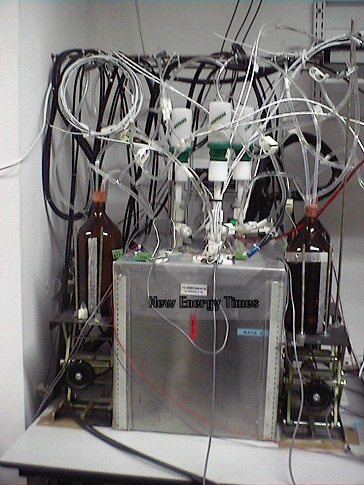
Energetics Technologies thermostated water bath.
Three cells are inside box,
brown bottles are D2O,
which is fed into cells to keep them topped off.
Devices with green rings are recombiners.
The next step in the SRI protocol is a "complete transfer of procedures and performance characteristics from the guest to the host, complete when the experiment is running to the satisfaction of the originator, and the host scientists believe they understand what is being done and what is required."
Only when steps 1 and 2 are complete do SRI researchers attempt to "improve" and enhance the experiment.
In this set of experiments, SRI reported that "the underlying Energetics protocol was demonstrated to be sound"; however, SRI was able to rebuild the related electronics and bring greater sophistication to the data acquisition and analysis system.
Calorimetry
In the historical set of experiments by Fleischmann and Pons, they used isoperibolic calorimetry, which included as its key component a silvered dewar.
Consequently, the heat from this configuration left the cell by radiation. With a hard vacuum in the dewar, it provided the best insulator and a reliable constant from which to calculate the heat generation within the cell. They were able to measure heat precisely to 0.1 milliWatts.
Few if any researchers subsequently have had the motivation to build a custom calorimeter approaching that level; however, the signals in today's experiments do not require such sensitivity.
In the isoperibolic calorimeter used by Energetics and SRI in this set of experiments, the heat leaves by conduction. It is a double-wall isoperibolic type, the same design as used by Huggins at Stanford.
Temperature is measured on the inner wall and the outer wall of the calorimeter with platinum resistance temperature detectors. This design has a sensitivity of 25 milliWatts for power inputs lower than one watt and 50 milliWatts for inputs at or above the 1 Watt level.

|
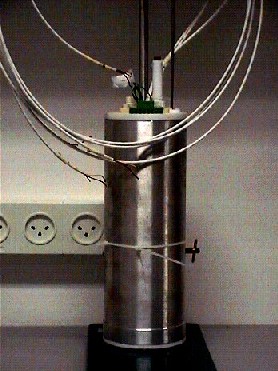
|
Diagram of Energetics Technologies cell
and calorimeter |
Assembled Double-Wall Isoperibolic calorimeter |
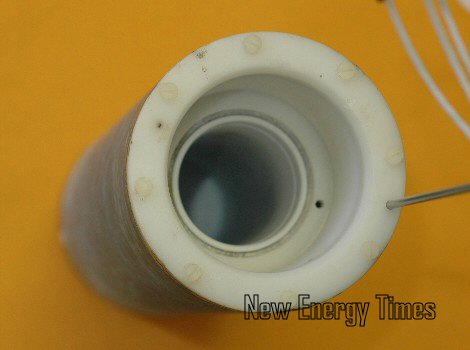
Looking inside empty double-wall isoperibolic calorimeter
The key to the double-wall design is alumina, aka aluminum oxide, Al2O3. The alumina distributes the heat throughout the calorimeter, very evenly, to minimize possible thermal gradients, which would produce skewed data. Alumina is one of the best conductors, and, ironically, aluminum is one of the worst conductors.
ENEA used a sophisticated thermostatically isolated mass flow calorimeter system to measure the heat in its experiments.
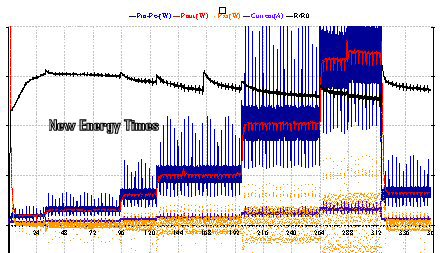
Above is an example of a calibration test from Energetics Technologies. As the current is stepped up (thin purple line), the power increases synchronously (thick blue line). The power out (thin red line) follows the steps of the power in and is centered within each of the plateaus. The excess power (broad orange band) remains centered around the baseline.
A subtle detail that McKubre pointed out is the slight delay as the power out (heat) is detected.
"This damping effect is entirely consistent with the time constant of the calorimeter," McKubre said. "That, as well as the other data here, shows that the calorimeter is well-calibrated and accurate over a wide dynamic range."
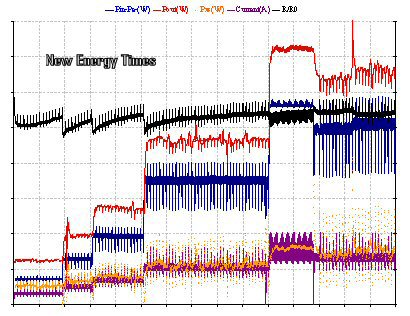
Alternatively, this graph shows the excess heat effect, right from the beginning of the data sample. The power out is clearly and consistently above the power in. About three-quarters of the way through, the researchers modified the character of the SuperWave and triggered a large burst. When they switched the SuperWave back to the original waveform, the excess power returned to the previous level relative to the power in.
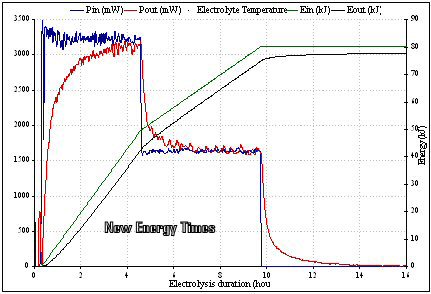
In this experiment, the power in matches power out. The excepted delay as a result of the flow calorimetry time constant is evident in each of the three steps. The difference between the energy in and the energy out shows the efficiency of the calorimeter.
An intriguing experiment with an Energetics cell running at SRI, with SRI data acquisition, showed an excess heat result that began in the first 10 hours of an experiment and produced an average of 300 milliWatts of excess power for 150 hours. This is one of many experimental results which demonstrate that storage of energy is not responsible for the excess heat results.
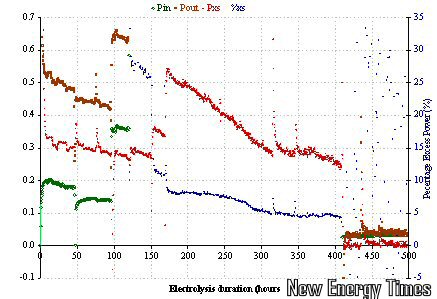
Energetics cell running at SRI showing excess heat beginning within the first 10 hours of cell operation, running for 150 hours
Another interesting thing happened in a cell running at ENEA. The excess heat began to rise around hour 65, and just before 68 hours, a power burst appeared. Simultaneously, an internal resistance temperature detector measured a burst in cell temperature. As well, the power consumption dropped as a result of the increased resistance inside the cell. The cell was running constant current.
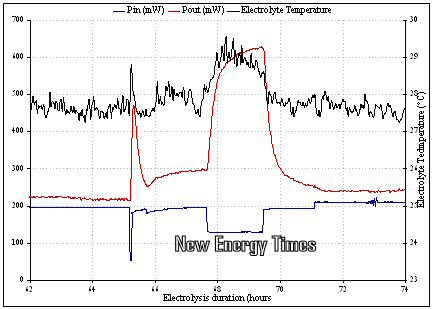
ENEA excess heat burst
McKubre speculates that the cathode got very hot, very fast, causing the drop in power. The drop, from 200 mW to 125 mW, occurred within a few minutes.
The burst produced 500 mW of excess power from a 125 mW input. McKubre said the maximum uncertainty of this calorimeter was 2.5 percent.
Experimental Results Summary
Four characteristics of the experiments are notable:
1. Consistently high levels of loading
2. High rates of deuterium flux into the palladium
3. High reproducibility of the excess heat effect
4. High percentage of excess heat relative to input power
ENEA reported that 60 percent of the cells in this set of experiments produced significant excess heat. SRI reported that 70 percent of theirs showed significant excess heat.
"Of the fifteen experiments performed using SRI data acquisition," McKubre said, "eleven produced excess heat at or above the 3 sigma experimental uncertainty."
Among the most successful experiments, the teams reported the following:
Lab |
Cell # |
Excess Power
% of Power In |
Excess Power
mW |
Excess energy
kJ |
Sensitivity
mW |
ET |
56 |
80% |
3000 |
3100 |
50 +/-25 |
ET |
64a |
2500% |
1900 |
1100 |
50 +/-25 |
ET |
64b |
1500% |
1100 |
4600 |
50 +/-25 |
SRI |
11-8 |
60% |
340 |
514 |
not given |
SRI |
35-7 |
12% |
1800 |
553 |
not given |
SRI |
35-8 |
13% |
2066 |
313 |
not given |
SRI |
43-7 |
80% |
1250 |
245 |
not given |
SRI |
51-9 |
43% |
79 |
28 |
not given |
SRI |
56-7 |
15% |
2095 |
536 |
not given |
SRI |
58-9 |
200% |
540 |
485 |
not given |
ENEA |
L17 |
500% |
495 |
<10 |
50 +/-15 |
ENEA |
L19 |
100% |
3000
(estimated on transient) |
not given |
50 +/-15 |
ENEA |
L23 |
37% |
not given |
not given |
50 +/-15 |
ENEA |
L25A |
24% |
45 |
not given |
50 +/-15 |
ENEA |
L30 |
700% |
7000 (estimated on transient) |
not given |
50 +/-15 |
Note: The length of the foils used at ENEA and SRI are 20 mm and 60mm respectively
Challenges
Besides the struggle that face nearly all LENR researchers - funding - the team has had a few challenges.
The Omer, Israel, team purchased the identical cold roller used by the ENEA team and attempted to make palladium foils that generated excess heat, to no avail. So far, only the ENEA team appears to have the skill and/or the know-how to fabricate the foils so they produce LENR excess heat.
Also, unrecognized variations in the original source of the palladium, directly from the manufacturer, introduces critical variations that can make or break the ability of specific lots to succeed or fail in the experiments.
Conclusion
This year's results are an order of magnitude larger - 1000 and 2000 milliWatts of excess heat - than most previous sets of LENR experiments. The results have given rise to real hope that a viable pathway to a practical source of new clean energy may evolve from this once-discarded field historically known as cold fusion.
Perhaps it’s time to chart the progress of excess heat with LENR Progress Criteria. Fundamental milestones might be:
1. High reproducibility of any LENR nuclear phenomena.
2. High reproducibility of LENR excess heat at any statistically significant power level.
3. High reproducibility of LENR excess heat at the 1 Watt power level.
4. High reproducibility of LENR excess heat at the 1 kiloWatt power level.
Milestone 1 may have been achieved with the SPAWAR co-deposition experiment where tracks similar to those produced by charged particles were reproducibly seen in solid state nuclear track detectors (see the 2007 Galileo Project Report).
New Energy Times has and will continue to view LENR research from a practical, conservative point of view. The recent progress suggests that the additional milestones may not be far away.
__________________________________________________________________________________
13. Tritium Discoveries
By Steven B. Krivit
One year has passed since I notified Donald Kennedy, editor of Science, and hand-delivered to John Holdren, AAAS board of directors chair, notification that their journal had made a significant mistake.
They published a news story written by Gary Taubes that contained imaginary speculations that John O'Mara Bockris at Texas A&M University had falsified confirmatory LENR results by spiking his groups' electrolytic cells with tritium.
I informed them that Taubes' claims not only were speculative but also were proved wrong by Edmund Storms when he was at Los Alamos National Laboratory. (Storms is on the board of directors for New Energy Institute, the parent organization of New Energy Times.) On a personal level, Science and Taubes defamed one of the world's pre-eminent electrochemists.
Science thus far has chosen to ignore the matter. Consequently, New Energy Times is publishing the letters that Science should have published.
A full collection of the related correspondence is here, under the heading "Tritium Discovery at Texas A&M: An Assault on Legitimate Scientific Research."
Science apparently had been and remains unaware of the enormous body of tritium research and results obtained by the Bhabha Atomic Research Centre in India. The BARC research may represent the most comprehensive tritium research in the field of LENR.
Unfortunately, the upper management of BARC at the time lost confidence in LENR, despite many strong and positive results that their researchers obtained under the leadership of Mahadeva Srinivasan and P.K. Iyengar. The collateral damage from the Taubes-Science article took its toll in the subsequent fallout.
The good news is that New Energy Times has learned that Srinivasan and other Indian researchers are making progress in reigniting LENR interest and that several colloquia are scheduled in India for January.
Tritium generation from LENR experiments continues to be observed, though infrequently. Recently, at the Eight "Anomalies" conference in Catania, Michael McKubre of SRI International reported a set of experiments that gave a record level of repeatable and reproducible loading and excess heat results.
In the set of experiments that obtained high loading, only one did not produce excess heat; instead, it produced tritium. McKubre did not elaborate on the details.
__________________________________________________________________________________
14. Edmund Storms' Letter to Science, June 25, 1990
Sir:
This is a letter to the Editor concerning the article written by Gary Taubes (Science June, 1990). I request this be published in Science as soon as possible in fairness to Texas A&M University in particular and to the field of cold fusion in general.
The accusation made by Gary Taubes that cold fusion cells at Texas A&M University were "spiked" with tritium can be easily tested. It is not even necessary to trust the people at Texas A&M or Mr. Taubes. All that is required is to add tritium to an electrolytic cell and see if it behaves like the tritium claimed to be produced from cold fusion. This has been done and the results show that the tritium claimed to result from cold fusion can not be caused, at least in some cases, by the addition of tritiated water. Unfortunately, many of the cells at Texas A&M were not studied in sufficient detail to allow this conclusion to be applied to every cell. Nevertheless, the reality of tritium production as a phenomenon can not be challenged on the basis of this accusation. I sent the results described herein to Gary Taubes (4/9/90) before his article was published. Unfortunately, he chose to ignore this information.
In order to arrive at the above conclusion, two factors need to be compared. One factor is based on the time history of tritium concentration in the electrolyte and the other is based on the distribution ratio (tritium in the evolved gas divided by that in the electrolyte).
Cells that are claimed to produce tritium show a characteristic pattern of tritium production. After a time interval that can be as short as several days or as long as several months, the tritium content of the electrolyte begins a steady increase that lasts several days to several weeks. Bursts in the production rate have been observed. After the cell stops production, the tritium content rapidly decreases over several days and approaches a constant loss rate. The initial loss of tritium is caused by removal of dissolved DT gas from the electrolyte by the constant production of D 2 gas at the cathode and the later loss rate is caused by dilution. Dilution results from replacing the electrolyzed fluid and sampling specimen by heavy-water having a lower tritium content.
Figure 1 shows this behavior for a cell (#4) studied at Texas A&M[1]. The gas phase over this and several other cells at Texas A&M contained a much higher tritium concentration for a brief time than did the electrolyte. This indicates that the production rate of DT gas exceeded the rate at which it could exchange with dissolved gas as the evolved gas bubbled through the electrolyte. These bursts of tritium in the gas correspond to measured increases in the tritium content of the electrolyte. Therefore, some of the tritium generated at the cathode was able to enter the electrolyte as DT and/or DTO. Because the sampling interval was only daily and because of the unknown amount of recombinate, it is not possible from this figure to compare the total amount of tritium in the gas to that in the electrolyte. After the last tritium burst, the tritium content of the electrolyte decreased and approached a constant rate of decrease after several days.

FIGURE 1. The plotted disintegration rate is that in excess of the normal tritium content of the electrolyte. [1] No excess tritium was seen until 23 days after electrolysis started. Excess heat at a level near 18% was measured before, during and after tritium production with an indication of bursts in heat production coinciding with the tritium bursts. The light lines are drawn only to show how the data are connected in time.
Figure 2 shows the behavior of a cell studied at Los Alamos which was in a group of active cells. Interestingly, cell #4 at Texas A&M and the group at Los Alamos started producing tritium within 10 days and stopped within one day of each other. In contrast to the Texas study, the tritium production rate in the Los Alamos cell was so low that excess tritium was not found in the gas phase. The same tendency exists to show tritium bursts and to show a relatively rapid decrease in tritium content over several days after production ceased.

FIGURE 2. This was a sealed cell containing a catalyst which allowed the gas to recombine and collect separately as the recombinate. Details can be found in ref. [2]. All tritium entering and leaving the cell was measured. The standard deviation of the disintegration rate for the electrolyte is ±14 d/min-ml, about the size of the points. A larger error is expected for the recombinate because of the way samples were taken. The disintegration rate is plotted as a function of time after electrolysis was started on 9/7/89.
To test the behavior of a spiked cell, we added tritiated water to an inactive D 2 0 cell that had been running for 125 days without producing tritium. After the tritium was added as HTO, a complete inventory was kept of tritium that was added to the cell in the replacement D 2 0 and that left in the gas phase and during sampling. Figure 3 shows the tritium concentration in the electrolyte as a function of time. [3] The steady drop is caused by dilution when the electrolyzed D 2 0 was replaced by D 2 0 having a lower tritium content. In addition, a small amount of enrichment would be associated with this process because the gas has a lower T/D ratio than does the liquid. If these two factors are taken into account, the excess tritium content of the electrolyte remains constant. This analysis shows that there is no mechanism to cause the tritium content of the electrolyte to drop rapidly to a constant rate of decrease if tritium is added as tritiated water. The addition of tritiated water produces a constant rate of loss immediately after its addition. Only the addition of gaseous tritium would produce behavior similar to that observed in the cold fusion cells. It is hard to believe that someone at Texas A&M would realize this behavior to be characteristic of cold fusion cells, have HT or DT gas available and have the equipment to bubble this gas through the electrolyte at just the right rate.

FIGURE 3. The standard deviation of the disintegration rate is ±14 d/min-ml. The disintegration rate is plotted as a function of time starting at an arbitrary time.
The appearance of a high tritium concentration in the gas phase (Fig. 1) also sheds light on this issue. Both experiment and theory agree that the addition of tritiated water does not change the distribution ratio significantly. Even extreme changes in cell conditions are found to produce values between 0.45 and 0.65. Yet, several cells at Texas A&M showed more than 100 times as much tritium in the gas as in the electrolyte. Again, this behavior is not consistent with tritiated water being added to the cells. Of course, tritiated water could have been added to the collected recombinate to make the gas phase appear to be high in tritium. The need to do this would have had to be recognized and the amount chosen correctly at the right time. Although this possibility can not be ruled out, it seems very unlikely to me. In addition, if cell #4 had been spiked, the job would not have been simple nor quickly done.
According to the cold fusion group at the University of Utah, tritium has been produced by at least 20 groups throughout the world. In addition, over 60 groups have found some evidence for the cold fusion effect including heat, neutrons, protons, gamma rays and X-rays. Some of this work, especially in India[4] and Japan, has been very successful and is being published regularly in Fusion Technology as well as in other journals. To suggest that the cold fusion effect is not real because there is a suspicion of fraud and contamination at one institution, is exceedingly irresponsible.
Sincerely,
Edmund Storms
[1] J. O'M. Bockris, G. H. Lin and N.J.C. Packham, "A Review of the Investigations of the Fleischmann-Pons Phenomena, Fusion Technology, July (1990).
[2] E. Storms and C. Talcott, "Electrolytic Tritium Production", Fusion Technology, July (1990).
[3] E. K. Storms and C. Talcott, "A Study of Electrolytic Tritium Production", The First Annual Conference on Cold Fusion, Salt Lake City, Utah, 28 Mar. 1990.
[4] P. K. Iyengar and M. Srinivasan (ed.), "BARC Studies in Cold Fusion" Bhabha Atomic Research Centre, Trombay, Bombay, BARC-1500, Dec. 1989. Will appear in Fusion Technology, July (1990).
__________________________________________________________________________________
15. Bockris' Letter to Science, June 29, 1990
Dr. Daniel Koshland Editor,
SCIENCE 1333 H Street N.W.
Washington, DC 20005
Dear Dr. Koshland:
To carry out research on the anomalous effects described by Fleischmann and Pons in 1989 is an endeavor needing much courage. It requires months long electrolysis at very high current densities and then only a small fraction of the electrodes give the anomalous neutron, heat and tritium bursts which some interpret as signs of fusion in solid state confinement. Partly because of the difficulties of reproducing results, and partly because the branching ratio found does not fit the expectations of plasma physics, there is a very high degree of skepticism towards, and indeed considerable hostility to, those who are trying to find the facts among some very anomalous happenings (now reported from 60 Laboratories in 12 countries).
What was the purpose, then, of Science employing a journalist who is also a Hollywood screen writer, and a past contributor to Playboy, - to write a gossip-based account which, by strong innuendo, suggests that a graduate student faked results of some of the observations made here? And why publish such a damaging account without first asking evaluatory comment on its contents by those directly concerned?
1. There might be spot contamination by tritium of some pieces of old palladium although it is difficult to understand why the metal hydroxide impurity supposed to contain T does not yield up this substance when the hydroxide decomposes thermally during the melting (1552°C) the metal undergoes on the way to becoming a wire.
If any tritium really were present, it. still has to undergo the process of anodic dissolution into the solution surrounding the Pd electrode, where it is found. Attempts to find it in corresponding light water electrolysis, using Pd alleged to contain tritium, have failed. Calculations of the rate of anodic dissolution of the tritium under conditions of strong cathodic electrolysis, shows a calculated rate many orders of magnitude less than that observed when T is produced in Pd-D 2 0 electrolysis.
Reports of T in solution after electrolysis of D 2 0 on Pd have come from 26 laboratories, including three U.S. National Labs. Some have used the so-called fusion Pd from Johnson Matthey where the recipient is the first user. I conclude that the hypothesis that the T observed is the so-called "Cold Fusion" which comes from contaminated Pd is less likely than several other hypotheses.
2. Graduate Student Spiking?
Results in the 105 - 106 dpm ml-1 have been sporadically reported from the University of Florida, Los Alamos National Lab, by eleven independent groups at the Bhabha Atomic Research Center in India and at Texas A&M. My graduate student mush have done a great deal of unauthorized travel if he spiked solution of all these groups. To believe all these organizations have a secret spiker reminds one that the the author of the June 15 article is a Hollywood screen writer.
Objective tests for spiking have been devised by Storms and Talcott of the Los Alamos National Laboratory. They involve comparison between the behavior of the T activity with time after production in a purposely spiked solution and one which gets its T whilst evolving D2 on Pd. The behavior we have in our cells, when they do produce T, is unmistakenly consistent with the non-spiking behavior.
Had Science given us the opportunity to comment on the journalist's material before publication, these matters could have been pointed out. Science could then have told the journalist what Nature told him when he submitted his article (last April) to that journal.
Yours sincerely,
J. O'M. Bockris
Distinguished Professor of Chemistry
Texas A&M University
__________________________________________________________________________________
16. Nuclear Power and the Indo-U.S. Nuclear Deal
By P.K. Iyengar
|
From the editor:
A major proposal known as the 123 Agreement, formally as the Agreement for Cooperation Between the Government of India and the Government of USA Concerning Peaceful Uses of Nuclear Energy, is under consideration in India. The agreement will create the structure and working agreements for the future of India's nuclear energy sources.
The 123 Agreement follows from the U.S. Atomic Energy Act of 1954, in which international agreements for cooperation come under clause 123 of the act. The Department of Energy has used the term '123 Agreement' in all bilateral agreements with other countries.
Although conventional nuclear energy is on the periphery of the scope of New Energy Times, it is part of a larger picture. Eventually, low energy nuclear reactions will have a viable place in the nuclear energy spectrum alongside conventional nuclear energy solutions. For this reason, this essay provides valuable insight into several important areas: modern nuclear fission technology (versus decades-old U.S. technology), the paths chosen for India's nuclear energy, the geopolitical implications of India's plans for tomorrow, and the ever-present balancing act between the constructive and destructive applications of energy.
This article was originally written for and submitted to a popular Indian newsmagazine and reflects that region's perspective. New Energy Times strives to represent the international science community and is pleased to present this view from P.K. Iyengar, retired chairman of the Atomic Energy Commission in India. |
Preface
The urge to use neutron-induced fission to produce energy (explosive or continuous) was the main purpose of the Manhattan Project, and it succeeded in both. In addition to the atomic bomb, this resulted in priority for compact-core reactors for propulsion in submarines. That was the beginning of light-water reactors using enriched uranium. This technology was turned over to General Electric and Westinghouse, and they scaled it up to 220 MW and later to 1,000 MW.
The development of the technology for pressure vessels of this large size depends on industrial infrastructure. India doesn't have that infrastructure. Countries like France, England, Canada, and the Soviet Union developed power stations burning natural uranium, which of course produces plutonium as a byproduct. The compactness of the light-water reactor eventually took over if the country had enrichment capability because of its defence efforts. Thus, the nuclear-weapon countries dominate the scene with light-water reactors.
India chose to follow the pressurized heavy water reactor route because of the strong collaboration with Canada, which pioneered this reactor. The availability of natural uranium, zirconium, and production facilities for heavy water, in combination with fertilizer plants, gave further advantages to India. From 220 MW reactors, it has built and operated 550 MW reactors. The major advantage of the reactor is the relative size of the components that could be manufactured locally. Eventually, as in Canada, 1,000 MW reactors can be built.
The development of reactor technology has demonstrated how basic concepts in nuclear science can influence the systems chosen for commercialization. Avoiding enrichment capability, which is expensive, was the main motivation for India to go for this system. Reprocessing is a relatively simple technique involving chemical engineering. The conversion of 238U to 239Pu is also more efficient in the reactors. The fast reactor breeds more Pu than it burns. Also, thorium could be used in its blanket to convert it to 233U. Hence, India planned to develop fast-breeder technology and use its vast resources of thorium for deriving fission energy. More modern scientific developments have shown that, with an appropriate design of mixed-oxide fuel, one could even burn fertile material in situ, in thermal and fast reactors.
This paper emphasises the achievements of India in developing a self-reliant fission energy programme for the country. At the same time, the world market for reactors is dominated by the pressurized light water reactor, essentially arising from the weapon countries. The globalization of nuclear technology was inhibited by the Nuclear Non-Proliferation Treaty promulgated in 1968 and by the Nuclear Supplier Group's guidelines much later.
Should nuclear power become a more common source of electrical energy in the world, it can't be monitored by a small organization like the International Atomic Energy Agency, unless it has enormous manpower and financial resources. Just like we cannot safeguard dual-use technology in steel-making or internal combustion engines, one cannot safeguard against the use and misuse of nuclear technology throughout the world.
Second, many practical applications of science are compulsions of local conditions. India, being a vast country with enormous need for additional electrical power, needs to choose systems that will grow locally without external inputs. Although the Indo-U.S. 123 Agreement provides for the import of reactors and the specialized fuel for it, it is extremely expensive in the context of the Indian economy. Moreover, because India is not a Nuclear Non-Proliferation Treaty country, the 123 Agreement has specified unacceptable political conditions, which makes it sensitive from a political angle. This paper describes the technical alternatives.
Introduction
Nuclear power is essential to the future of the world. This is based on the high cost of oil, the limited resources of fossil fuels on the planet, and the dangerous effect of emissions from fossil fuels on our climate. For a large, fast-growing country like India, nuclear power is doubly important. The Indo-U.S. nuclear deal is supposed to address our growing need for nuclear power. To decide whether this particular deal is beneficial for the country, we must perform a detailed cost-benefit analysis. Because these are deeply technical matters, politicians or diplomats alone cannot do this; it has to involve scientists.
Based on such an analysis, one has to reject the Indo-U.S. nuclear deal in its present form, because its benefits are outweighed by its costs in terms of the conditions imposed on independence of action.
Need for Deal
Two major types of benefits are advertised: access to the latest technology to strengthen the indigenous programme, and access to uranium and to reactors to augment power production. Of these, the former is incorrect. The indigenous programme is based on heavy-water reactors, fast-breeder reactors, and thorium utilization. The U.S. programme is based on light-water reactors, and even these have not been built in the U.S. for 25 years. In fast-breeder technology, India is well advanced. Unlike India, the U.S. and other Western countries have easy access to uranium and few resources of thorium, so they have no interest in thorium use. Finally, 90 percent of the components in India’s reactors are indigenous. So what technology import are we talking about? Focusing, instead, on the export of nuclear technology would be economically more fruitful for India!
Access to uranium and additional power-producing reactors is also hyped-up. The deal does not involve selling India uranium at subsidized or fixed prices. It only allows India to buy uranium from the market. Similarly, the deal does not guarantee India a single new reactor. It only makes it possible for India to explore the international market and negotiate to buy reactors at market prices. The price of uranium is $85 per pound, up from $20 per pound three years ago. If the demand from India and China goes up, the price can only go up further. Overall, the cost of electricity from imported reactors will be more than the cost from indigenous reactors. In addition, one can expect a host of legal wrangles, including the issue of government guarantees, in importing such expensive and sensitive items. Further, India has to submit to intrusive safeguards, the character of which have changed and will continue to alter. Being a nonweapon country, India will be at the receiving end without any option for withdrawal.
The costs of the deal, on the other hand, are substantial. The most important one is that it will seriously affect national security. Further testing is essential for India to develop and maintain a credible nuclear deterrent. That will become impossible, in spite of the repeated assertions that the agreement does not infringe on India’s sovereign right to conduct nuclear tests. Imagine that the 123 Agreement is indeed ratified and operationalized, and India has imported 5,000 MW of reactors. If changed geopolitical circumstances make it desirable, even imperative, for India to conduct nuclear tests, no reasonable Indian government of the future would dare to do so, given the large dependence on power from the imported reactors. In other words, when India signs the 123 Agreement, it also will be signing away the ability to act independently in the strategic sphere. The argument that testing is not essential is contradicted by the actions of the U.S. itself. Even after 60 years of weapons development and 2,000 tests, after the end of the Cold War and the emergence of a ‘unipolar’ world, the U.S. wants to start a reliable replacement warhead project, to invent new nuclear weapons and to maintain stockpiles in operating readiness. Further, the Russians announced the other day a new weapon called the ‘father’ of non-nuclear weapons. Does this presage a return to the Cold War days, and if so, will we not need to be well-prepared?
So, if India needs more nuclear power and if the Indo-U.S. nuclear deal is not acceptable, then what are the alternatives? Let me address these alternatives in some detail.
Reactor Options
We have chosen the pressurized heavy-water reactor route to nuclear power. These reactors use natural (that is, unenriched) uranium as fuel and heavy water as moderator. The technology for making the components for such a system, from developing exotic materials like zirconium, to the control electronics, to the turbo-generator, has been developed in the country. Two 550 MW electrical power stations have been built and are operating at Tarapur, which the prime minister recently dedicated. Work is on hand to scale up the design to 700 MW in the new power stations to be built. The economics of nuclear power based on an indigenous industry also has been proved. The clamour for the import of light-water reactors of 1,000 MW capacity is therefore only like importing high-end cars. It is not the work-horse for securing nuclear power for the future of the country.
Light-water reactors from the U.S. are not the only option. Recently, the head of Atomic Energy of Canada Ltd. issued a statement (published by the Press Trust of India) which talks of modified CANDU reactors that will use MOX fuel involving plutonium and thorium and thus introduce thorium in the fuel cycle earlier than fast-breeder reactors – an old concept similar to the advanced heavy water reactor but using the same hardware as CANDU, which will make it most economical. He also welcomed cooperation in introducing it in India since India established reprocessing and MOX fuel-making facilities 15 years ago. India should grab such opportunities because it has demonstrated successful cooperation. It also will free India from the hold of enrichment cartels.
Another direction is to accelerating the fast-breeder programme. Breeder reactors make more fuel than they burn. Theoretical concepts that will allow in situ burning of fertile material like depleted uranium and thorium also are coming, especially from the Bhabha Atomic Research Centre in Mumbai. Because of the high-temperature sodium that is used as the heat removal agent, they have higher efficiency in converting heat to electricity. The prototype fast breeder reactor project will establish India’s independent capability in this area. To speed up large-scale commercialization, India should invest in one more such reactor as well as in reprocessing plants. Dedicated reprocessing plants with International Atomic Energy Agency and U.S. approval under additional protocol can be a nonstarter if India goes by previous experience. The dedicated reprocessing plant as envisaged in the 123 Agreement will need at least 10 years to provide plutonium fuel for India’s fast reactors. Does India wait for another six yeas or more to reprocess the accumulated fuel from the light water reactors at Tarapur?
Availability of Uranium
India’s needs and its mining and processing of natural uranium have been mismatched. which has produced a bottleneck in operating pressurized heavy-water reactors. This has occurred for several reasons: the high cost of production because of the low grade of the ore, diversion of uranium for enrichment for strategic purposes, and lower burn-up in the reactors for operational reasons. At one stage, importing yellow cake from the international market was desirable, but it was prevented by India’s dearest friends even though India offered safeguards. As the Australian prime minister recently declared, if India signs the 123 Agreement, Australia will consider supplying uranium to India, because India will have effectively signed the Non-Proliferation Treaty, something Indian governments have refused to do for years. Should India really panic at this stage? Does this not give India an opportunity to plan better, fuller use of the unburnt fuel in existing reactors, the Tarapur reactor in particular, and not be content with just burning less than 1 percent of the uranium that India has mined and used? The Canadian approach described earlier is one example of reducing India’s requirement of fresh natural uranium. The advanced heavy water reactor concept is again a feasible proposition, but it has not proceeded fast enough. In any case, for the good of the world, when every uranium atom is fissionable, India should try to make it possible rather than wasting most of it, as the U.S. has over the last 35 years. Special scientific committees in the U.S. have advocated reprocessing of commercial fuel and use of the fissile material more effectively, but the insistence on the ‘black box’ nonproliferation regime advocated self-denial in that country. Only Japan has very strong interest in reprocessing light-water reactor fuel, to make it a richer energy source.
Uranium ore was not considered a valuable material until the discovery of fission. It had very little practical use as a chemical substance. Therefore, there wasn’t much interest in exploration for uranium deposits. Only now do we find that uranium is getting to be more important, even compared to oil and gas. The resource must be spread more uniformly on the planet than we think it is. Research and development in uranium exploration hasn’t received enough attention. The discovery of rich ores in Africa, Canada and Australia and their easy access to the U.S. prevented commercial interests for exploration. In the Soviet Union, because of its connection with defence needs, there was no question of costs, and therefore exploitation of even low-grade ore has gone on for years. If India proves a greater percentage of burn-up of uranium, then the cost consideration may not apply.
What about the availability of uranium in non-Nuclear Suppliers Group countries? Several areas in Africa and South America have uranium ore. They are not members of the Nuclear Suppliers Group. Unfortunately, the commercial industries in advanced countries quickly grab control over these sources and prevent free trade. The question may be asked whether controlling trade in natural uranium is called for to implement the nonproliferation regime. But they make the rules.
Barter Deals
During the early years of Indian independence, Homi Bhabha complained to Pandit Nehru about an attempt to internationally control even the mines of exotic materials in developing countries. The Atomic Energy Act in India, thanks to his efforts, described in detail the atomic minerals and prescribed that the ownership and control rest with the government. Once, in Parliament, Panditji even talked of how India cannot agree to international control of mining operations. The export of beach sands was stopped and was taken over by the Department of Atomic Energy. Nobody had a right to export monozyte without approval of the department, which bought that portion of the mineral sands for stockpile. There is a complaint that right now the beach sands are being exported illegally from the southern tip of the country, and there is even a court case in Madurai.
When necessary, Homi Bhabha also resorted to bartering strategic materials in return for equally important equipment. A 6 MeV van de Graff accelerator, a state-of-the-art machine made by High Voltage Corp., then coming into vogue for nuclear research, was imported by bartering mineral sands to the U.S. The beryl ore, which contains beryllium, another strategic material, was bartered with France for sharing the technology of making beryllium oxide, as well as using it as a moderator in a reactor, under joint collaboration with Saclay, France. India has capability in nuclear technology, ranging from isotope production, research reactors, use of isotopes in health and industry, heavy water – a very sensitive material for reactors – zirconium and its alloys for components of nuclear reactors, as well as beryllium metal. At a crucial stage like this, when international cartels, not market forces, control trade, India needs to think of bartering this material with non-Nuclear Suppliers Group countries, who are not bound by Nuclear Suppliers Group rules. More uranium is dissolved in the ocean waters, and when researchers succeed in extracting that from sea water, there could be no control over the uranium supply. For that, effective research and development is required.
Separation Plan
In the July 2005 statement, India offered to provide a plan for separating its facilities into civilian and military. The option of putting the civilian facilities under International Atomic Energy Agency safeguards, and at what time, was supposed to have been left to India. However, it took seven months, until March 2006, in lengthy discussions with the U.S. to arrive at an agreement coinciding with the visit of President Bush. Because the separation plan is applicable only to weapon states, it was presumed that the U.S. had at last accepted India as possessing nuclear weapons and having a strategic programme. However, the nonproliferation lobby in the U.S. had argued that the separation plan violated the Nuclear Suppliers Group requirement of full-scope safeguards, which means all facilities should come under International Atomic Energy Agency safeguards. The U.S. Congress eventually passed the Hyde Act with the sole aim of restricting the availability of basic material for weaponisation and putting many restrictions on India’s reprocessing facilities. This was to make it acceptable to the U.S. Congress, which in turn brought in the termination clause on the nuclear tests such that India doesn’t make further progress in this field. Even though India protested, the U.S. administration could not influence the decision of Congress. The 123 Agreement does not mention an agreement about the separation plan, which clearly shows that the U.S. has left the burden of agreeing to the details of the separation plan to the International Atomic Energy Agency, under the India-specific safeguards agreement that is to be negotiated. Getting the Department of Atomic Energy to agree to this separation plan was not an easy task, because the facilities weren’t built like that. Now the International Atomic Energy Agency can ask for a complete list of nuclear facilities, ask why only certain facilities are put under the civilian list, and question the timing. It logically can put restraints on the use of any of these facilities from one sector to another. When India signed an agreement with Pakistan not to attack each other’s nuclear facilities, India had to declare which nuclear facilities, which certainly revealed information that was not necessarily in the public interest. In the same way, the International Atomic Energy Agency India-specific agreement also may be injurious to India’s strategic programme. Surprisingly, the separation plan is neither an agreement nor a unilateral declaration by India. The Nuclear Suppliers Group will have a chance to pick holes in the separation plan. Therefore, the claim that the 123 Agreement solves all problems satisfactorily is not necessarily true.
Conclusion
The scientists have no fears about importing light-water reactors along with the fuel, to augment nuclear power sources. India has, for example, started off our nuclear power programme with the Tarapur light-water reactors, imported from the U.S. We have the Kudankulam project, which has 1,000 MW reactors built in collaboration with Russia, which is a Nuclear Suppliers Group country and has agreed to supply fuel for its lifetime. Other countries have bought light-water reactors, like Japan, South Korea, and China. But what is questionable about the Indo-U.S. deal is the insistence on conditions extraneous to nuclear power, about which the media have elaborated. Even Supreme Court lawyers and judges have pointed out how amending the national law by the U.S., under the Hyde Act, is not sufficient to give India the freedom to pursue its strategic programme and continue its three-phase power programme without strings attached. If the U.S. trusts India as a strategic partner that believes in the nonproliferation regime and will not do anything to support attempts at making weapons of mass destruction in other countries, they should trust that India’s efforts in enhancing its abilities in reprocessing technology is purely for its fast-reactor programme and thorium use. India doesn’t have to fall in line with U.S. thinking on the next-generation reactors or what the programme is to enhance nuclear power in their countries. On the other hand, competition in nuclear technology could lead to safer, more economic and cost-effective systems being developed by India and China, taking into account the much lower cost for research and development as well as the manufacturing of components.
The growth of nuclear power in India has to be based on expanding its indigenous capability, rather than importing the reactors as well as the fuel. To stockpile 40 years of fuel for a nuclear power station is certainly not economical, considering the high interest rates in India. It also speaks of a lack of confidence in India’s ability to expand the enrichment capability, as well as making the MOX fuel, which also can be used in the light-water reactors. India must allow future generations of scientists and engineers to develop new systems, so that India demonstrates to the rest of the world that it is capable of leading the world in nuclear technology. The advanced heavy water reactor and the fast-breeders are examples.
Nuclear science will progress, and new options will appear, as long as people are willing to think, experiment and innovate. Cold fusion and low energy nuclear reactions focused in this magazine are important. Controlling the thinking process is the worst thing that can happen to any country. Well-established infrastructure can decay quickly if rational progress is not maintained. Even the U.S. will find it difficult to get manpower if a sudden decision is made to climb back onto the nuclear bandwagon. Political decisions cannot create capability overnight. It has to be nurtured and grown in a systematic manner, without entanglements, as in the proposed deal. That requires political decisions beyond pure finances and economics. The debate is not about survival but about progress. For example, if India hadn’t expanded agricultural production, wouldn’t it be importing food at enormous cost, upsetting the economy? If India hadn’t built large-scale steel and cement industries, would its industrial capacity and growth rate have reached its present status? Mere foreign investment in terms of dollars is not enough to sustain a growth rate, unless it is backed by productivity in agriculture, industry, and education. India is reaping the benefits of a high level of education in the software industry, but this has to be backed by a sustained growth in technology. The satellite-launching capability demonstrated by the Geo-Synchronous Launch Vehicle is an example of how the future can be secured by a consistent policy based on self-reliance.
The scientists’ opposition to the nuclear deal is not based on capitalism or socialism but on allowing indigenous growth in capability in nuclear technology, which will assure energy security in the long run. No economist has ever proved that out-sourcing nuclear technology for sustaining power growth in India is feasible or warranted. The sacrifices made in the past and those to be in the future are testimony to a vision that originated with Nehru and Bhabha and that was sustained for generations by a political will. Perceptions on nonalignment and global trade can change, but it has to be realistic, taking into account the teeming population, the opportunity for jobs, and the building of capabilities in industry, defence, and agriculture. A holistic view of progress is what is called for, and perhaps a rededication of what happened in space and atomic energy in the past is the best way to growth in the future.
__________________________________________________________________________________
17. PUBLICATIONS
New Book by Edmund Storms
The Science of Low Energy Nuclear Reaction: A Comprehensive Compilation of Evidence and Explanations about Cold Fusion by Edmund Storms (retired from Los Alamos National Laboratory, USA) is now available from Amazon ($71) and other outlets. The book was published by World Scientific Publishing Co.
From the back cover:
"One of the most important discoveries of this century — cold fusion — was summarily rejected by science and the media before sufficient evidence had been accumulated to make a rational judgment possible. Enough evidence is now available to show that this rejection was wrong and that the discovery of a new source of clean energy may help solve some serious problems currently facing mankind. The book catalogues and evaluates this evidence and shows why the initial reaction was driven more by self-interest than fact. This book is essential reading for anyone who wants to understand the history and science behind the cold fusion controversy. In addition to the technological importance of the effect, the discovery of new ways to initiate nuclear reactions without producing significant radiation reveals an entirely new mechanism operating at the nuclear level in solid material. This new mechanism has important implications for an understanding of many other phenomena."
Widom-Larsen Papers
Lewis Larsen, president and CEO of Lattice Energy LLC in Chicago, Ill., and Allan Widom of Northeastern University, in Boston, Mass., continue with the expansion of their theoretical model to explain LENR phenomena.
On Sept. 8, they, along with Yogendra. N. Srivastava, released their fifth paper in this series, "Energetic Electrons and Nuclear Transmutations in Exploding Wires," to the arXiv preprint server, and on Sept. 25, they released an updated version of their fourth paper in the series, "Theoretical Standard Model Rates of Proton to Neutron Conversions Near Metallic Hydride Surfaces."
Larsen included the following text with the announcement of their fifth paper:
"In this paper, we extend our theory of low energy nuclear reactions (LENRs) beyond the domain of relatively low temperature chemical cells to include closely related nuclear phenomena that occur in much more energetic, violent environments associated with high-current exploding wires.
"One aim of our paper is to resolve an old controversy. In 1922, Wendt &Irion, two chemists from the University of Chicago, reported the results of relatively simple experiments that consisted of exploding tungsten wires with a very large current pulse under a vacuum inside of sealed glass ‘bulbs.’ A huge controversy erupted because Wendt and Irion claimed to have observed the presence of anomalous helium inside sealed bulbs after the tungsten wires were blown, suggesting that transmutation of hydrogen into helium had somehow occurred during the ‘disintegration of tungsten.’ Widespread press coverage triggered a response from the scientific establishment in the form of a negative critique of Wendt and Irion's work by Ernest Rutherford that was published in Nature. Rutherford won the contemporary debate; he was believed; Wendt and Irion were not. After 1923, Wendt and Irion abandoned their exploding wire experiments and turned to other lines of research.
"Until recently, this controversy had been almost totally forgotten. However, it now appears to us that Rutherford was incorrect in his criticisms; Wendt and Irion were right. First, we cite recent experimental evidence on exploding wires that decisively settles the experimental issues in favor of Wendt and Irion. Neutrons are produced in such experiments, making it entirely plausible that nuclear transmutations can occur. Second, we cite additional recent experiments in which ‘fast neutrons have been seen in exploding wires even though there were no deuterons initially present.’ Since distinctive gamma signatures have not been observed along with any such neutrons, it appears unlikely to us that D-D fusion is the mechanism responsible for producing them.
"We also aim to resolve the remaining theoretical issues. Utilizing collective effects with electrons in wires, well-established physics, and only four equations, we go on to explain a ‘theoretical paradox in low energy nuclear reactions that has remained unresolved for over eight decades.’
"We conclude, ‘It is presently clear that nuclear transmutations can occur under a much wider range of physical conditions than was heretofore thought possible.’
"The resolution of this 85-year-old controversy is especially poignant when one considers that (a) in 1920 Rutherford himself had predicted the existence of a neutral nuclear particle with ~ the same mass as a proton, saying that it could be formed by the capture of an electron onto a proton, (b) the existence of the neutron would not be experimentally verified by James Chadwick until 1932, and (c) fission would not be discovered by Otto Hahn and Fritz Strassman until 1938."
|
Larsen included the following text with the announcement of version two of their fourth paper:
"This paper was initially published under nucl-th in the arXiv on August 25, 2006, and submitted to a major peer-reviewed journal soon thereafter. After a year, it is still undergoing a protracted process of peer review. Rather than continuing to wait for a final decision on publication, we decided to communicate our expanded manuscript to the scientific community for whatever benefit others might derive from it.
"Responding to editors' and referees' comments and requests for additional explanatory details, we have expanded the original manuscript from seven to 12 pages. There are now in-depth discussions of important topics such as neutron and electron scattering as they relate to understanding collective oscillations of protons or deuterons found on metallic hydride surfaces. We also calculate a ~ 5,000 K ‘noise temperature’ for micron-scale ‘hot spots’ that can be observed in the infrared on surfaces of operating LENR cathodes - we believe that this may explain the seemingly explosive 'cratering' and 'ejecta' features commonly seen in post-experiment scanning electron microscope (SEM) images of such surfaces.
”We have added 19 new references relating primarily to the topic of proton/deuteron surface oscillations as well as to prior work by others in the field of low energy nuclear reactions (LENRs).”
|
Ronald C. Bourgoin Paper
Inverse Quantum Mechanics of the Hydrogen Atom: A General Solution,
Adv. Studies Theor. Phys., Vol. 1, 2007, no. 8, 381-393.
Institute of Science in Society Articles
An interesting set of articles on CMNS/LENR has appeared on a London, U.K.-based organization's Web site recently.
http://www.i-sis.org.uk/HowColdFusionWorks.php
http://www.i-sis.org.uk/coldFusionCondensedMatter.php
http://www.i-sis.org.uk/alchemistsDream.php
Among their technical and in-depth scientific reviews, they mention interesting things about the Widom-Larsen theory.
"The neutrons yielding the abundances in our local solar system and galaxy have often been previously assumed to arise entirely from thermonuclear processes and supernova explosions in the stars. . . . The story of our universe [as it] has been created may well have to be rewritten."
The Institute of Science in Society is a not-for-profit organization that is concerned with science and the environment. Its founder and director is Mae-Wan Ho. The institute has been very active in the genetically modified food debate.
Further information about the organization and founder is located here.
__________________________________________________________________________________
18. SCIENCE AND ENERGY NEWS
Click on any headline to read the entire article.
Cold Fusion Appears Again
Steve Reucroft and John Swain
CERN Courier
Wednesday, July 18, 2007
Cold fusion is one of those topics that just keeps coming back, most recently as reported in an article in Naturwissenschaften. Frank Gordon of the US Navy's Space and Naval Warfare Systems Center in San Diego and colleagues have reported new evidence for low-energy fusion in a palladium-deuterium film deposited on nickel.
(article continues)
Pollution Absolution
By Matt Smith
SF Weekly
Wednesday, July 18, 2007
Leave it to the Vatican to place itself on the wrong side of yet another great moral divide.
This July, the Holy See announced it would become the first fully green sovereign state by accepting a donation of "carbon credits" from a subsidiary of Planktos, a Foster City firm hoping to profit from the global market in CO2 offsets the scheme whereby companies, individuals, and now nations can buy forgiveness for their global warming sins.
Planktos says it plans to plant trees in Hungary to offset any pollution the Vatican produces in Rome. But this papally blessed publicity stunt seems designed to provide a PR benefit for Planktos' main line of business, which involves making money by dumping perhaps illegally hundreds of tons of iron ore into the sea.
(article continues)
China, Filling a Void, Drills for Riches in Chad
By Howard W. French and Lydia Polgreen
The New York Times
Monday, August 13, 2007
Chad is as geographically isolated as places come in Africa. It is also among the continent’s poorest and least stable countries, the scene of recurrent civil wars and foreign invasions since it gained independence from France in 1960.
None of that has put off the Chinese, though. In January, they bought the rights to a vast exploration zone that surrounds this rural village, making the baked wilderness here, without roads, electricity or telephones, the latest frontier for their thirsty oil industry and increasingly global ambitions.
(article continues)
Córdova Reviews Misconduct Standards Amid Debate
By Andrea Thomas
The Purdue Exponent
Friday, August 17, 2007
Despite facing two accounts of research misconduct allegations this year and pressing skepticism from the scientific community, Purdue professor Rusi Taleyarkhan still holds that he created bubble, or sonofusion - a tabletop experiment that could lead to an alternative to fossil fuels.
The controversy, said Steven Krivit, editor of The New Energy Times, is far from over.
In July, The New Energy Times published a 110-page report on the bubble fusion controversy, which outlined the history, investigation and assessment of Taleyarkhan's research. The report was intended as a reference work for program managers, policy makers, scientists, scholars, historians and journalists, containing "the bare minimum of synthesis and interpretation, and is anything but brief and succinct," Krivit wrote.
(article continues)
Euro Hits New High; Oil Nears $80 a Barrel
By Vikas Bajaj
The New York Times
Thursday, September 13, 2007
The dollar fell to a new low point against the euro yesterday and oil prices surged to a record, suggesting that a weaker American economy would be accompanied by higher prices for energy and other imported products.
As of late yesterday, the euro traded in New York at $1.3908, up from $1.3832 late Tuesday; the European common currency has risen 5.4 percent against the dollar so far this year and about 1 percent this week.
(article continues)
Planktos II: The Intervention
Podcast hosted by Alex Smith
Ecoshock News
Sunday, September 16, 2007
Russ George has a persistent critic online, the editor of a newsletter on Fusion Energy, called New Energy Times - one Steve Krivit. Distrusting claims made by D2Fusion, Krivit has checked on the company. Krivit says the truth has been stretched, sometimes to the breaking point. In particular, he found that neither the Los Alamos National Laboratory nor Stanford Research Institute acknowledges successful fusion testing by Russell George.
(article continues)
Environmental Groups Say Carbon Credit Company Made False Claims to SEC
Friends of the Earth press release
on Common Dreams website
Friday, September 21, 2007
Several environmental organizations have filed a letter with the Securities and Exchange Commission (SEC) to express concern about potentially illegal statements made by the "eco-restoration" firm Planktos, which is planning a massive iron dump into the Pacific ocean near the Galapagos Islands in a scheme designed to produce carbon offset credits that can be sold for profit.
The International Environmental Law Project, the International Center for Technology Assessment, Fishwise, Greenpeace, the ETC Group, and Friends of the Earth today notified the SEC that Planktos' recent SEC filings contain false information regarding the applicability of U.S. environmental laws to its activities. Additionally, the groups' letter said statements made by Planktos CEO Russ George may mislead investors about the financial and environmental benefits of selling the carbon offset credits that Planktos claims it will be able to generate.
(article continues)
Approval Is Sought to Build Two Reactors in Texas
By Matthew L. Wald
The New York Times
Tuesday, September 25, 2007
In a bid to take the lead in the race to revive the nuclear power industry, an energy company will ask the federal Nuclear Regulatory Commission on Tuesday for permission to build two reactors in Texas.
It is the first time since the 1970s and the accident at Three Mile Island that an American power company has sought permission to start work on a new reactor to add to the existing array of operable reactors, which now number 104.
(article continues)
Hype on Nuclear Power is Misleading
By Brahma Chellaney
The Japan Times
Thursday, September 27, 2007
Talk of a "global nuclear renaissance" remains just that — all talk. Notwithstanding the strong public relations campaign by the nuclear power industry and its powerful lobbying groups, nuclear energy is hardly the answer to the twin challenges of carbon mitigation and energy security that the world confronts.
Indeed, ever since the talk began in the mid-1990s, the share of nuclear power in global electricity has stagnated at 16 percent. Today, 429 power reactors worldwide generate 370 gigawatts of electricity, with just another 24 under construction, mostly in developing countries.
(article continues)
Is There a Third Route to Produce Nuclear Energy?
By M. Srinivasan
Former Scientist, BARC
The Hindu
Thursday, September 27, 2007
At a time when there is an intense debate going on in the country on the Indo-US nuclear deal, and the role of nuclear power in meeting our future energy needs, it may be worth taking note of the fact that nuclear fission reactors (and in a longer time frame thermo nuclear fusion) are not the only routes available to tap the immense energy locked in the atomic nucleus.
A third route — cold fusion (CF) — does exist. The cold fusion approach was disclosed in 1989 by two electro-chemists — Fleischmann and Pons in the U.S.
The phenomenon, once known as cold fusion, but now more accurately regarded as low energy nuclear reactions, represents a significant paradigm shift in our understanding of nuclear phenomena.
(article continues)
Scientists Ask Congress To Fund $50 Billion Science Thing
The Onion
Friday, September 28, 2007
Top physicists from several major American universities appeared before a Congressional committee Monday to request $50 billion for a science thing that would further U.S. advancement science-wise and broaden human knowing.
(article continues)
Britney Spears Solves Cold Fusion Formula
By drugtestallpoliticians
TheSpoof.com
Sunday, October 7, 2007
Everyone knows Britney Spears lost her child custody battle recently but few realize that she earned her doctorate in cosmic unification theory and nuclear physics in record time.
This week she put her science degrees to good use as she solved the remaining problems which had long prevented cold fusion technology from being put to use to solve the Earth's energy problems.
(article continues)
China Sets Up Expert Panel on International Fusion Energy Project
China Daily
(Xinhau News Agency)
Wednesday, October 10, 2007
China on Tuesday set up a national expert committee on magnetic confinement fusion energy to ensure its implementation in the landmark multinational fusion energy project.
The International Thermonuclear Experimental Reactor (ITER) has been the largest ever scientific research program under multinational collaboration. The 11-billion-euro project is aimed at developing a sustained solution to energy production.
The committee, established by the Minister of Science and Technology (MST) and other government agencies, will supervise the implementation of China's share of ITER tasks and domestic research into fusion energy.
(article continues)
Power Plant Rejected Over Carbon Dioxide For First Time
By Steven Mufson
The Washington Post
Friday, October 19, 2007
The Kansas Department of Health and Environment yesterday became the first government agency in the United States to cite carbon dioxide emissions as the reason for rejecting an air permit for a proposed coal-fired electricity generating plant, saying that the greenhouse gas threatens public health and the environment.
The decision marks a victory for environmental groups that are fighting proposals for new coal-fired plants around the country. It may be the first of a series of similar state actions inspired by a Supreme Court decision in April that asserted that greenhouse gases such as carbon dioxide should be considered pollutants under the Clean Air Act.
(article continues)
High-Priced Oil Adds Volatility to Power Scramble
By Mark Landler
The New York Times
Wednesday, November 7, 2007
As the price of oil surges toward a symbolic milestone of $100 a barrel — hitting $96.70 yesterday — it is creating new winners and losers across the globe.
The prospect of triple-digit oil prices has redrawn the economic and political map of the world, challenging some old notions of power. Oil-rich nations are enjoying historic gains and opportunities, while major importers — including China and India, home to a third of the world’s population — confront rising economic and social costs.
(article continues)
________________________________________________________________________________
Support New Energy Times(tm)
New Energy Times (tm) is a project of New Energy Institute, an independent 501(c)(3) nonprofit corporation that provides information and educational services to help bring about the clean-energy revolution.
The New Energy Times (tm) newsletter, Web site, and documentary projects are made possible by the generous contributions of our sponsors and supporters.
__________________________________________________________________________________
Administrative
Copyright 2007 New Energy Times (tm)
Publication, in print or electronically, is not permitted without express written permission.
|

